

The Admissions Strategist
How to use an anecdote to write a powerful college essay (with plenty of examples).
Do you need help finding best-fit colleges or writing essays? You can sign up for a free consult here .
“Tap, tap, tap. My fingers danced across the computer keyboard which, while attempting to distract myself from the task at hand, I pretended was a piano. The made-up tune was rhythmic and catchy, but I made sure never to press hard enough on the keys to actually start typing. I remember glaring at the blank document on the screen which seemed to mock me with an ever-blinking cursor and chanted, “write, write, write.” I would eventually write the dreaded essay but not until the clock hands were well past midnight, I had sampled every snack in the pantry, and had typed “akdgja” or some other unintelligible word 37 times in my word processor.”
If you have ever stared at a blank document or piece of paper and were unsure of what to write, you might identify with the description above.
I could have simply expressed this idea to you by writing, “I understand what it feels like to be frustrated and not know what to write.” Instead, I chose to begin with an anecdote.
An anecdote is a brief and engaging story that is used to illustrate a point. Most importantly, anecdotes are true stories about your life.
College admissions committees are interested in your life experiences , what makes you different from other students, and why you would make a great college student.
By using anecdotes in your college essay writing, you have the ability to create a powerful bond between you and your audience.
These stories help convince readers of your sincerity and engage them in your life story .

Click above to watch a video on how to use an anecdote in your essay.
Statement or Anecdote: What’s the difference?
There is certainly a time and place for using brief, non-descriptive statements in college essay writing .
When describing your family, you might note that you have two younger sisters.
Unless your essay is focused on your sisters, there is no need to launch into a story about the day your sisters were born.
However, if there is an idea or experience that you would like an admissions committee to focus on, then you might be better off using an anecdote.
Let’s look at an example:
If using a statement, you might write in your essay that failing a test was a turning point in your educational career, and that it made you a better student.
While that seems like an interesting enough statement, it is not enough to prove that you were transformed.
A powerful and convincing strategy would be to instead tell the story of how after failing your first AP Psychology exam, you started recording class lectures, taking chapter notes, and created a study group.
You might then describe the feeling after taking the next exam and finding out that you and your study group all received significantly higher scores.
This anecdote confirms the idea that you want to get across (you learn from past mistakes) by giving a specific example that your reader can imagine and with which they can identify.
What makes an effective anecdote?
Anecdotes should not be used thoughtlessly to build word count. Rather, be purposeful in the stories that you tell.
Effective anecdotes are:
- Descriptive
The anecdotes you choose to share in a college essay should be fairly short in order to avoid losing your reader’s attention.
Short stories also ensure that you still have space to thoroughly address a prompt.
To stay brief, remember that it’s unnecessary to tell a story from beginning to end.
- Instead, focus on the most important event while providing just enough context for it to make sense to someone outside of your circle of friends.
- When including anecdotes, also use descriptive writing. You want your reader to be able to use the detail in your college essay to paint an image in their mind.
In the following example, a student was asked to write about their hometown for a college essay.
Rather than describe its geographical location and basic demographics, they use anecdotal and descriptive sensory writing to evoke an emotional response from their readers.
Anyone can look up facts about a city on the Internet or in a guidebook, but only you can tell the story of your life through your own eyes :
“One road runs straight past Mann’s Red and White store, past two kids racing on four-wheelers, past a sign supposed to read Pine Acres, but is missing the C, and finally loops around to the Fisherman’s Wharf Restaurant and fishing docks. It’s evening and large fishing trawlers bring home catches of shrimp. The parking lot across the street is filled with empty eighteen-wheelers. Men in the warehouses wear knee-high white rubber boots, often called ‘Wanchese house slippers,’ and pack the catch in ice. As the sun sets, the town’s children return from their small boats and kayaks to the canals within Wanchese. They run home, covered in mud and dirt and their skin is tanned from endless hours in the sun, but they smile and are ready to do it again tomorrow.”
This brief anecdote describes the sights and sounds of the town, while also conveying the freedom neighborhood kids had to run around and play.
Finally, be sure that the anecdote you choose to include in your essay is relevant. While the story you describe might be funny or interesting, if it does not address the prompt or further the point you are making, it will only be considered a distraction.
Get personalized advice!
Where should i include an anecdote.
Structurally, there are two different parts of a college essay where an anecdote is often found.
The first is at the very beginning, and, in this case, your anecdote is used as a “hook” to engage your reader .
One of the best ways to begin a college essay is with a “cold hook.” A cold hook is an abrupt anecdote that pulls the reader into your essay right away.
Here are examples of a cold hook anecdote:
I was angry. I was confused. “Okay, almost there! Only a few more strokes.” Upon finishing my painting, I reflected on my journey to the final round of the art show. As we took our first couple steps off of the plane, the hot and humid air swarmed around us.
At the beginning of this article, I described the experience of having writer’s block and the distracting habits I turn to when I’m feeling stuck.
When using an anecdote as a hook, you want to consider what you can write that will be both relevant to the prompt, and compel your audience to continue reading.
Another way to include an anecdote in your essay is to use a story to illustrate a point.
Let’s say that you were given a prompt that asked you to write about a problem you have solved. In your response, you might include an anecdote about the time you wrote a letter to the editor to highlight an ongoing problem in your neighborhood.
You then describe the events that followed which led to a solution.
This response is an example of how you could use an anecdote to prove that you have solved a problem.
More Examples of College Essay Anecdotes
Of course, you are probably looking for real-life examples of anecdotes in college essays that worked. Below, you’ll find a list of both pithy and detailed anecdotes for now-successful graduates. Enjoy!
Here’s a student setting the scene before giving a major presentation:
I moved centerstage of the massive arena with my two teammates by my side. Bright lights and thousands of eyes gazed at me. It’s showtime.
This is a student discussing the struggles of learning an instrument:
I had to teach myself how to read notes and play the strings. In the end, I spent hundreds of hours and countless nights watching tutorials, trying to translate the foreign language of music.
This is a student battling anxiety and failure:
Trapped in a hurricane of doubt, I searched for the eye of the storm. I had to calm down and seek a break from the failure.
From a student who loves languages:
As I spoke with numerous professionals at the conference, I felt like French had been a part of my life since the very beginning.
From another student who did some great charity work:
Altogether, we raised $15,000 for veterans. During the process, not only did we pair veterans with corporate mentors, but our team became more involved with veterans PTSD issues and fundraising. I had found my calling.
From a student who loves working with animals:
Outside of school, I care for two rescue dogs, a showy and energetic American Cocker Spaniel and a shy but regal English Cocker Spaniel. They haven’t let their traumtic pasts affect their moods, and neither will I.
This is a student who writes about his love for politics:
During my first year participating in my Junior Statesmen of America chapter, I never spoke up for my beliefs or views regarding current events. Over the next two years, I changed my mindset and became willing to fail and face disagreemnt over my views. My willingness to discuss issues led me to become president of the chapter, where I involve classmates and speak to the younger students about volunteering for local campaign.
From the desk of a student who fell in love with a school after discovering an alumnus:
After concluding my visit to DC, I listened to a speech from Senator Warner, a voice for reason in a time of great confusion. I curiously Googled his history, learning that he is an alum. Senator Warner, I discovered, demonstrates why GW is the perfect university for me.
From a student who loves UPitt:
From the moment I stepped on PITT’s campus, I felt fully immersed in the community. When I began the tour, a lively environment greeted me with students who were enthusiastically wearing PITT spirit wear and eager to help me find my way around campus. My student tour guide seemed to know everything about the school. The student pride was inspiring, and she created a family environment I wanted to a part of.
A student and actor who loves West Side Story :
Playing Chino was the greatest challenge I have ever faced as an actor. Witnessing the pure hatred presented in the musical forced a transformation not only in my character onstage, but also in me. I saw myself and every person in Chino; for, we all work hard to achieve what is best for ourselves and for our compatriots.
From a student and EDM composer:
A pulsing drumbeat flows through my headphones, outlining the foundation for a song. Moments later, the strong sounds of a driving base line blast through the white noise of the underlying percussion. The melody pours onto the track making way for a wave of rhythm and flow. Thus begins a song; my song. Like a brush upon canvas, music notes fly across my open laptop screen. I am the artist of this song, this blend of emotion and color, this complexly beautiful composition that is my life.
A student reflecting on his role in the family:
I recently heard an NPR segment about the effects of the one-child policy in the People’s Republic of China. It described how the country has essentially produced an entire generation of “Little Emperors” that command the sole attention of their doting parents. Being a male only-child in an Asian family, hearing this story prompted immediate introspection. I began to wonder – if I could build a prototype based on the alleged qualities of a Little Emperor, how would I compare?
From a student remembering his father:
One of my earliest memories of my father’s gravy was when I performed in my first piano recital. I remember completing my simple version of Silent Night, and as I hit the last note and prepared to stand up and take my vow, my father’s face stuck out in the crowd. I remember seeing my dad laughing and clapping, that unmistakable smile stretching across his face, and his thoughts as clear as his expression: “That’s gravy!”
From a gritty student who had to take care of his family from an early age:
I vividly remember hanging onto her legs, horrified, as she hung from a third story window in an attempt to end her life. Her caustic lifestyle made her vicious, manipulative, and vindictive towards everybody in her life, pushing everybody that loved her away. She stole thousands of dollars from my mom via check fraud, which made my mother unable to afford the rent to our house, clothes, or even food. It became my responsibility, seeing as I had a paying job since I was thirteen, to step in and help make ends meet.
A student discussing his love for the beach:
Sitting against the backdrop of stars, I then noticed the boats gently drifting on the ocean, taking me back through the tides of time to my childhood. These boats reminded me of my own boating trips with my grandfather and my next door neighbor. During fishing trips we took every three weeks, my grandfather continually talked about customers and sales from his business, introducing me to the world of economics and finance.
Transitioning from an anecdote
It is important not to “drop” an anecdote into your essay without transitioning back to your main idea.
If you don’t use transition statements, your reader might be left confused as to why you used an anecdote and your college essay could seem disjointed.
Consider these sentence starters when transitioning from an anecdote back to the main body of your essay:
- This experience led me to understand/realize…
- This is just one example of how…
- [Summary of anecdote] was significant because…
When writing a college essay, remember that style is often as important as content . Including these transition statements will help you to get your intended message across.
What if I don’t have any stories to tell?
Many students struggle with including anecdotes in their writing because they think nothing interesting or tragic has ever happened to them.
While “shocking” anecdotes about life-changing events can be great examples to illustrate struggle, they are not the only effective anecdotes.
Hold a magnifying glass to your life and think about a time where you were challenged and, as a result, learned something.
Your life does not need to have been in danger and no monument needs to have been erected in your honor.
Think: What events in my life (no matter how big or small) have led to me growing as a human being?
These are stories worth telling.
Conclusion: The College Essay Anecdote
Don’t be afraid to use an anecdote in your college essay. In fact, we recommend it. Keep it brief and relevant.
College admissions officers want to learn about you and your values. Anecdotes help you extrapolate important or pertinent events from your life.
Best of luck!
Learn how we can help you with college and career guidance! Check out our YouTube channel!
Click Here to Schedule a Free Consult!

Stay on track and ease your anxiety with our second-to-none college application assistance.

- Ethics & Honesty
- Privacy Policy
- Join Our Team
(732) 339-3835

How to Write a Great Anecdote
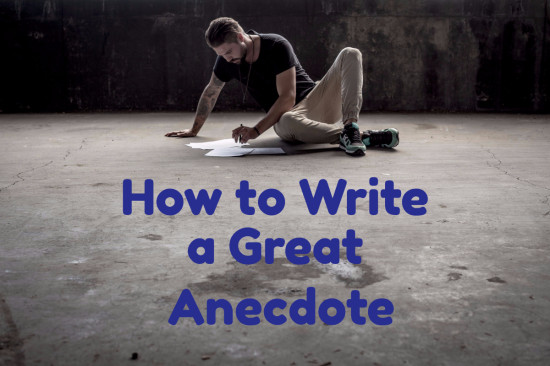
Why Use Anecdotes?
Anecdotes are used to give a personal perspective, illustrate a point, make people think about something, or make them laugh. One of the places where you might find anecdote writing useful is when writing a college application essay . Perhaps something that happened in your life inspired you to study in a certain direction, and you’d like to share the story to show why you are highly motivated to do well.
Non-fiction, informal essays can also be livened up with anecdotes that show how the information you’re sharing works in practice, and why people need to know about or think about the topic. For example, when I write about gender discrimination in the workplace, I always remember to point out that women can also be guilty of this.
A female boss I worked under years ago didn’t like hiring young women, “They’re just going to get married and move away or have babies, and then we have to give them maternity leave,” she would say. This illustrates that women are sometimes also guilty of gender discrimination.
You can also use anecdotes to amuse or entertain. Not all anecdotes are serious! If something really funny happens to you today, you’ll tell your friends, won’t you? That’s an anecdote! Here’s one of my favorites:
My brother used to have an absolute obsession with answering the phone in time. He would get quite agitated if it stopped ringing before anyone picked up. One day, the phone started ringing while he was in the bathroom. He called out in a panicky voice, “Ring the phone! It’s answering!” The phone didn’t get answered. I was laughing much too hard for that!
How to Write an Anecdote
First, be sure the anecdote you have in mind is relevant to the context . If you are writing about dogs, for example, an anecdote about a cat is irrelevant. Ask yourself, “Why do I want to use this anecdote? What point does it illustrate?”
Next, consider these questions:
- Who was involved in the story?
- What happened?
- When did it happen? Is this relevant?
- Where did it happen? Is this relevant?
Because an anecdote is a mini-story, you structure it in the same way that you would structure a longer piece. You introduce the story, you say what happened, and you either draw a conclusion or ask a question so your reader can reach his or her own conclusion.
The main point you’re trying to get across is your “punchline” (whether it’s funny or serious), so save it for last. The first thing to mention is the person or group of people directly involved in the story. In my anecdote about a sexist female boss, I introduce her, but not the other people on the recruitment panel. They are not relevant to the story itself, so we leave them out.
We also don’t bother to mention the weather, the color of the boardroom furniture, and so on. These facts don’t contribute to the story. If they did, we could add them. Always remember you’re illustrating a point, and anything that doesn’t form part of that point will be a distraction.
Once you have introduced your players and have provided any necessary context to set the stage, you can move on to explaining what happened. Begin at the beginning and write the events chronologically. It’s possible to tell your anecdote differently, but this is the easiest way to keep it coherent and easy to understand. Lastly, state your conclusion, or ask your readers to draw their own conclusion.
The Differences Between Anecdotes and Stories
Anecdotes are short. At most, they will consist of a paragraph , or maybe two paragraphs . Stories are longer. When we write stories, we can include a lot more detail, and we will spend more effort on drawing the reader into the scene so that they feel part of it.
Can an Anecdote Be a Single Sentence? Yes, It Can
- “My cat always cuddles me in the morning.”
- “George is so polite, he always shakes hands instead of just greeting me.”
- “When I was a student, I worked in a bookshop after classes.”
Admittedly, these aren’t great anecdotes, but they are anecdotes nonetheless.
- Choose a relevant event that happened to you or someone else (even a famous figure).
- Is your story interesting, amusing, inspiring or thought-provoking? Try to aim for at least one of these.
- Structure your ideas.
- Tell your story briefly.
- Draw a conclusion.
Does anyone out there have an anecdote about anecdotes? Do tell!
I was reading an article about anecdotes, and in the process, I realized that I was creating my own anecdote learning what it takes to understand anecdotes.
Superb answer…It’s like an anecdote only ! I liked yours !
Can an anecdote also be a story? I’ve heard the phrase “anecdotal story” before so this leads me to believe that an anecdote can be a story, but you say there is a difference in one is short and one is long.
An anecdotal story is a short story about oneself.
Can an anecdote be fictional?
nah it has to be based on a real incident
My English teacher doesn’t need to know that…
Actually, it can be. I am just learning about anecdotes and informal essays.
An anecdote can be anything, fact or fiction, that helps develop, further or improve one’s narrative.
Yes, it can be. But it has to be realistic.
On the contrary, anecdotes may be unrealistic as well an obvious exaggeration as satire and sarcasm are often used by comedians.
Very very useful article Thank you very much …
But how would you follow after the story like what connects the hook and bridge.
There is a memoir by the entertainer Carl Reiner and the book cover calls it an anecdotal memoir! That works for me.
can I use an anecdote for a formal essay?
yes you can
this article was super helpful.. can anyone please share a three sentence anecdote of a personal experience you have had.
Our school conducted sports day in a near by school.I parked my vehicle in that school playground.I left my hand bag inside my vehicle and joined the sports meet. After sometime I heard that handbags left in vehicle were robbed. I rushed to see and found my handbag too got stolen. That day I learnt we should never leave our belonging gs in the vehicle even though it is locked.
How do you suppose you could use an anecdote as the conclusion in a biographical sketch?
I would think you would need a “concluding statement” of some kind, and then include an anecdote about the subject of the biography that hasn’t already appeared. Anecdotes, I think, need a “bridge” of some kind.
I’ve been searching for a way to explain, in understandable language, the process of writing an anecdote to my international college students (ESL). My brain is “fried” with teaching online, so I’ve turned to the friendly Internet. Breathing a sigh of relief.
Just say that it’s them describing a past experience.
I was trying to comment on this article after finishing it, I found lot of people already commented what i wanted to comment ! True,What you think become reality !
This article on anecdotes helped me to learn the following: (a.) it’s purpose, meaning, (b.) how to write a it, (c.) what needs to be included in my outline for my supportive evidential support by including facts, evidence, anecdote and structure. FYI: differentiate by color code. Thanks you
This was really helpful, thanks a lot.
Popular Posts
- The Top 10 Most Difficult-to-Spot Writing Mistakes
- 4 Simple Tips for Great Writing
- Avoiding Wordiness: 330 Examples & What to Use Instead
- The Oxford Comma: The Splice of Life
- Who vs. Whom
- Affect vs. Effect
- How to Take Notes: The 10-Step Guide to Note-Taking (Infographic)
- CMOS vs. AP – Recent Changes & Comparison (Updated 1. Nov. 2021)
- The Daily Word Counts of 19 Famous Writers
- The Ideal Length of Everything You Write Online ( Infographic)
Recent Comments
- admin on Privacy Policy
- kougra on Word Counter Reading Level Feature
- Sigma on Word Counter Reading Level Feature
- Mel S. on How Many Pages Is 2000 Words?
- Master_Cheeks116 on Word Counter Reading Level Feature

Session expired
Please log in again. The login page will open in a new tab. After logging in you can close it and return to this page.

Get science-backed answers as you write with Paperpal's Research feature
How to Write an Essay Introduction (with Examples)

The introduction of an essay plays a critical role in engaging the reader and providing contextual information about the topic. It sets the stage for the rest of the essay, establishes the tone and style, and motivates the reader to continue reading.
Table of Contents
What is an essay introduction , what to include in an essay introduction, how to create an essay structure , step-by-step process for writing an essay introduction , how to write an introduction paragraph , how to write a hook for your essay , how to include background information , how to write a thesis statement .
- Argumentative Essay Introduction Example:
- Expository Essay Introduction Example
Literary Analysis Essay Introduction Example
Check and revise – checklist for essay introduction , key takeaways , frequently asked questions .
An introduction is the opening section of an essay, paper, or other written work. It introduces the topic and provides background information, context, and an overview of what the reader can expect from the rest of the work. 1 The key is to be concise and to the point, providing enough information to engage the reader without delving into excessive detail.
The essay introduction is crucial as it sets the tone for the entire piece and provides the reader with a roadmap of what to expect. Here are key elements to include in your essay introduction:
- Hook : Start with an attention-grabbing statement or question to engage the reader. This could be a surprising fact, a relevant quote, or a compelling anecdote.
- Background information : Provide context and background information to help the reader understand the topic. This can include historical information, definitions of key terms, or an overview of the current state of affairs related to your topic.
- Thesis statement : Clearly state your main argument or position on the topic. Your thesis should be concise and specific, providing a clear direction for your essay.
Before we get into how to write an essay introduction, we need to know how it is structured. The structure of an essay is crucial for organizing your thoughts and presenting them clearly and logically. It is divided as follows: 2
- Introduction: The introduction should grab the reader’s attention with a hook, provide context, and include a thesis statement that presents the main argument or purpose of the essay.
- Body: The body should consist of focused paragraphs that support your thesis statement using evidence and analysis. Each paragraph should concentrate on a single central idea or argument and provide evidence, examples, or analysis to back it up.
- Conclusion: The conclusion should summarize the main points and restate the thesis differently. End with a final statement that leaves a lasting impression on the reader. Avoid new information or arguments.

Here’s a step-by-step guide on how to write an essay introduction:
- Start with a Hook : Begin your introduction paragraph with an attention-grabbing statement, question, quote, or anecdote related to your topic. The hook should pique the reader’s interest and encourage them to continue reading.
- Provide Background Information : This helps the reader understand the relevance and importance of the topic.
- State Your Thesis Statement : The last sentence is the main argument or point of your essay. It should be clear, concise, and directly address the topic of your essay.
- Preview the Main Points : This gives the reader an idea of what to expect and how you will support your thesis.
- Keep it Concise and Clear : Avoid going into too much detail or including information not directly relevant to your topic.
- Revise : Revise your introduction after you’ve written the rest of your essay to ensure it aligns with your final argument.
Here’s an example of an essay introduction paragraph about the importance of education:
Education is often viewed as a fundamental human right and a key social and economic development driver. As Nelson Mandela once famously said, “Education is the most powerful weapon which you can use to change the world.” It is the key to unlocking a wide range of opportunities and benefits for individuals, societies, and nations. In today’s constantly evolving world, education has become even more critical. It has expanded beyond traditional classroom learning to include digital and remote learning, making education more accessible and convenient. This essay will delve into the importance of education in empowering individuals to achieve their dreams, improving societies by promoting social justice and equality, and driving economic growth by developing a skilled workforce and promoting innovation.
This introduction paragraph example includes a hook (the quote by Nelson Mandela), provides some background information on education, and states the thesis statement (the importance of education).
This is one of the key steps in how to write an essay introduction. Crafting a compelling hook is vital because it sets the tone for your entire essay and determines whether your readers will stay interested. A good hook draws the reader in and sets the stage for the rest of your essay.
- Avoid Dry Fact : Instead of simply stating a bland fact, try to make it engaging and relevant to your topic. For example, if you’re writing about the benefits of exercise, you could start with a startling statistic like, “Did you know that regular exercise can increase your lifespan by up to seven years?”
- Avoid Using a Dictionary Definition : While definitions can be informative, they’re not always the most captivating way to start an essay. Instead, try to use a quote, anecdote, or provocative question to pique the reader’s interest. For instance, if you’re writing about freedom, you could begin with a quote from a famous freedom fighter or philosopher.
- Do Not Just State a Fact That the Reader Already Knows : This ties back to the first point—your hook should surprise or intrigue the reader. For Here’s an introduction paragraph example, if you’re writing about climate change, you could start with a thought-provoking statement like, “Despite overwhelming evidence, many people still refuse to believe in the reality of climate change.”
Including background information in the introduction section of your essay is important to provide context and establish the relevance of your topic. When writing the background information, you can follow these steps:
- Start with a General Statement: Begin with a general statement about the topic and gradually narrow it down to your specific focus. For example, when discussing the impact of social media, you can begin by making a broad statement about social media and its widespread use in today’s society, as follows: “Social media has become an integral part of modern life, with billions of users worldwide.”
- Define Key Terms : Define any key terms or concepts that may be unfamiliar to your readers but are essential for understanding your argument.
- Provide Relevant Statistics: Use statistics or facts to highlight the significance of the issue you’re discussing. For instance, “According to a report by Statista, the number of social media users is expected to reach 4.41 billion by 2025.”
- Discuss the Evolution: Mention previous research or studies that have been conducted on the topic, especially those that are relevant to your argument. Mention key milestones or developments that have shaped its current impact. You can also outline some of the major effects of social media. For example, you can briefly describe how social media has evolved, including positives such as increased connectivity and issues like cyberbullying and privacy concerns.
- Transition to Your Thesis: Use the background information to lead into your thesis statement, which should clearly state the main argument or purpose of your essay. For example, “Given its pervasive influence, it is crucial to examine the impact of social media on mental health.”

A thesis statement is a concise summary of the main point or claim of an essay, research paper, or other type of academic writing. It appears near the end of the introduction. Here’s how to write a thesis statement:
- Identify the topic: Start by identifying the topic of your essay. For example, if your essay is about the importance of exercise for overall health, your topic is “exercise.”
- State your position: Next, state your position or claim about the topic. This is the main argument or point you want to make. For example, if you believe that regular exercise is crucial for maintaining good health, your position could be: “Regular exercise is essential for maintaining good health.”
- Support your position: Provide a brief overview of the reasons or evidence that support your position. These will be the main points of your essay. For example, if you’re writing an essay about the importance of exercise, you could mention the physical health benefits, mental health benefits, and the role of exercise in disease prevention.
- Make it specific: Ensure your thesis statement clearly states what you will discuss in your essay. For example, instead of saying, “Exercise is good for you,” you could say, “Regular exercise, including cardiovascular and strength training, can improve overall health and reduce the risk of chronic diseases.”
Examples of essay introduction
Here are examples of essay introductions for different types of essays:
Argumentative Essay Introduction Example:
Topic: Should the voting age be lowered to 16?
“The question of whether the voting age should be lowered to 16 has sparked nationwide debate. While some argue that 16-year-olds lack the requisite maturity and knowledge to make informed decisions, others argue that doing so would imbue young people with agency and give them a voice in shaping their future.”
Expository Essay Introduction Example
Topic: The benefits of regular exercise
“In today’s fast-paced world, the importance of regular exercise cannot be overstated. From improving physical health to boosting mental well-being, the benefits of exercise are numerous and far-reaching. This essay will examine the various advantages of regular exercise and provide tips on incorporating it into your daily routine.”
Text: “To Kill a Mockingbird” by Harper Lee
“Harper Lee’s novel, ‘To Kill a Mockingbird,’ is a timeless classic that explores themes of racism, injustice, and morality in the American South. Through the eyes of young Scout Finch, the reader is taken on a journey that challenges societal norms and forces characters to confront their prejudices. This essay will analyze the novel’s use of symbolism, character development, and narrative structure to uncover its deeper meaning and relevance to contemporary society.”
- Engaging and Relevant First Sentence : The opening sentence captures the reader’s attention and relates directly to the topic.
- Background Information : Enough background information is introduced to provide context for the thesis statement.
- Definition of Important Terms : Key terms or concepts that might be unfamiliar to the audience or are central to the argument are defined.
- Clear Thesis Statement : The thesis statement presents the main point or argument of the essay.
- Relevance to Main Body : Everything in the introduction directly relates to and sets up the discussion in the main body of the essay.

Writing a strong introduction is crucial for setting the tone and context of your essay. Here are the key takeaways for how to write essay introduction: 3
- Hook the Reader : Start with an engaging hook to grab the reader’s attention. This could be a compelling question, a surprising fact, a relevant quote, or an anecdote.
- Provide Background : Give a brief overview of the topic, setting the context and stage for the discussion.
- Thesis Statement : State your thesis, which is the main argument or point of your essay. It should be concise, clear, and specific.
- Preview the Structure : Outline the main points or arguments to help the reader understand the organization of your essay.
- Keep it Concise : Avoid including unnecessary details or information not directly related to your thesis.
- Revise and Edit : Revise your introduction to ensure clarity, coherence, and relevance. Check for grammar and spelling errors.
- Seek Feedback : Get feedback from peers or instructors to improve your introduction further.
The purpose of an essay introduction is to give an overview of the topic, context, and main ideas of the essay. It is meant to engage the reader, establish the tone for the rest of the essay, and introduce the thesis statement or central argument.
An essay introduction typically ranges from 5-10% of the total word count. For example, in a 1,000-word essay, the introduction would be roughly 50-100 words. However, the length can vary depending on the complexity of the topic and the overall length of the essay.
An essay introduction is critical in engaging the reader and providing contextual information about the topic. To ensure its effectiveness, consider incorporating these key elements: a compelling hook, background information, a clear thesis statement, an outline of the essay’s scope, a smooth transition to the body, and optional signposting sentences.
The process of writing an essay introduction is not necessarily straightforward, but there are several strategies that can be employed to achieve this end. When experiencing difficulty initiating the process, consider the following techniques: begin with an anecdote, a quotation, an image, a question, or a startling fact to pique the reader’s interest. It may also be helpful to consider the five W’s of journalism: who, what, when, where, why, and how. For instance, an anecdotal opening could be structured as follows: “As I ascended the stage, momentarily blinded by the intense lights, I could sense the weight of a hundred eyes upon me, anticipating my next move. The topic of discussion was climate change, a subject I was passionate about, and it was my first public speaking event. Little did I know , that pivotal moment would not only alter my perspective but also chart my life’s course.”
Crafting a compelling thesis statement for your introduction paragraph is crucial to grab your reader’s attention. To achieve this, avoid using overused phrases such as “In this paper, I will write about” or “I will focus on” as they lack originality. Instead, strive to engage your reader by substantiating your stance or proposition with a “so what” clause. While writing your thesis statement, aim to be precise, succinct, and clear in conveying your main argument.
To create an effective essay introduction, ensure it is clear, engaging, relevant, and contains a concise thesis statement. It should transition smoothly into the essay and be long enough to cover necessary points but not become overwhelming. Seek feedback from peers or instructors to assess its effectiveness.
References
- Cui, L. (2022). Unit 6 Essay Introduction. Building Academic Writing Skills .
- West, H., Malcolm, G., Keywood, S., & Hill, J. (2019). Writing a successful essay. Journal of Geography in Higher Education , 43 (4), 609-617.
- Beavers, M. E., Thoune, D. L., & McBeth, M. (2023). Bibliographic Essay: Reading, Researching, Teaching, and Writing with Hooks: A Queer Literacy Sponsorship. College English, 85(3), 230-242.
Paperpal is a comprehensive AI writing toolkit that helps students and researchers achieve 2x the writing in half the time. It leverages 21+ years of STM experience and insights from millions of research articles to provide in-depth academic writing, language editing, and submission readiness support to help you write better, faster.
Get accurate academic translations, rewriting support, grammar checks, vocabulary suggestions, and generative AI assistance that delivers human precision at machine speed. Try for free or upgrade to Paperpal Prime starting at US$19 a month to access premium features, including consistency, plagiarism, and 30+ submission readiness checks to help you succeed.
Experience the future of academic writing – Sign up to Paperpal and start writing for free!
Related Reads:
- What is an Argumentative Essay? How to Write It (With Examples)
- How to Paraphrase Research Papers Effectively
- How to Cite Social Media Sources in Academic Writing?
- How Long Should a Chapter Be?
Similarity Checks: The Author’s Guide to Plagiarism and Responsible Writing
Types of plagiarism and 6 tips to avoid it in your writing , you may also like, how to structure an essay, leveraging generative ai to enhance student understanding of..., how to write a good hook for essays,..., addressing peer review feedback and mastering manuscript revisions..., how paperpal can boost comprehension and foster interdisciplinary..., what is the importance of a concept paper..., how to write the first draft of a..., mla works cited page: format, template & examples, how to ace grant writing for research funding..., powerful academic phrases to improve your essay writing .
How to Use Anecdotes to Nail Your Next Speech
- Writing Essays
- Writing Research Papers
- English Grammar
- M.Ed., Education Administration, University of Georgia
- B.A., History, Armstrong State University
An anecdote is a short scene or story taken from personal experience. Anecdotes can be useful for setting the stage for a speech or personal essay . An anecdote often relays a story that can be used as a theme or lesson.
- Pronunciation: AN - eck - doht
- Also Known As: incident, story, narrative, account, episode.
Examples of Usage
The story below could be used as an introduction to a speech or short story about personal safety:
"After the long Ohio winter, I was so happy to see the first signs of spring that I ran outside as soon as I saw our first flower blooming. I plucked the dewy, white blossom and tucked it into my hair band and went about my day with joy in my heart. Unfortunately, I didn't notice that my big white flower had been host to a dozen or so tiny bugs, that apparently enjoyed a new home in the warmth and security of my hair. I was soon itching and twitching like a scrappy dog. Next time I stop to smell the flowers, I'll make sure I'll do it with my eyes wide open."
The anecdote provides a lead-in to the overall message of your speech or essay. For example, the next sentence after the anecdote could be: "Have you ever delved head-first into a situation and run straight into trouble?"
Using Anecdotes to Set the Stage
See how this anecdote can provide a moral or backdrop for a speech or essay about staying alert? You can use many small events in your own life as anecdotes to set the stage for a greater message.
Another time when anecdotes are often used is during a seminar. For example, a seminar covering race car vehicle suspension may begin with a story about how the driver or engineer became aware of a strange problem with a car. Although the subject of the seminar may be highly technical, the introduction story — or anecdote — may be simple or even humorous.
School teachers and college professors will often use anecdotes as a way of easing students into a complex issue. It could be argued that using anecdotes this way is a "roundabout" way of introducing a subject, but people use examples in everyday speech to make a subject more easy to understand and to clarify the more complex part of a narrative to follow.
- Examples of Great Introductory Paragraphs
- The Top 20 Figures of Speech
- The 9 Parts of Speech: Definitions and Examples
- Figure of Speech: Definition and Examples
- Emma Watson's 2014 Speech on Gender Equality
- What Is an Anecdote?
- How to Write a Narrative Essay or Speech
- How to Write a Graduation Speech as Valedictorian
- 10 Great American Speeches for the 7-12 Classroom
- Figures of Speech: The Apostrophe as a Literary Device
- Anecdotal Evidence
- Definition and Examples of Analysis in Composition
- Learn How to Use Extended Definitions in Essays and Speeches
- Supporting Detail in Composition and Speech
- Write an Attention-Grabbing Opening Sentence for an Essay
- College Essay Style Tips
The power of anecdote: creative strategies for academic writing

Many of the freshmen I instruct at CUNY enter the first few sessions of my Expository Writing class wearing metaphorical top hats and monocles, armed with—and comforted by—the five-paragraph essay structure and other basic compositional building blocks. College-level essay writing, in their understanding, requires a stuffy, exacting formality—a holding in of one’s breath. By sublimating their individual perspectives and voices, these writers are, in fact, setting aside their most effective argumentative tools.
Aristotle and Me
Think of the most inspirational presidential addresses of the few decades, or, to be especially timely, of Oprah’s rousing Golden Globes acceptance speech. These speakers went far beyond oatmeal summation of why their issues were worthy of attention. Oprah, for example, began by vividly recounting her experience of watching Sidney Poitier win his Oscar when she was a child in 1964, going as far to describe the linoleum floor on which she was sitting. By setting herself squarely in the center of her argument about equality and inclusivity, many viewers were emotionally moved; some Twitter users were even galvanized into championing her presidential candidacy.
I encourage my students to research and write about topics they’re interested and invested in, which I’ve found immediately enlivens their argumentation. Caring about a subject is three-quarters of the battle, but because freshmen enter college with certain staid notions of academic writing—that, put concisely, it is more science than art—they forget the power of the personal.
Rhetoricians teach the argumentative tenets of ethos, logos, and pathos, but contemporary college students often feel alienated by Aristotelian terminology. In high school, students learned about logos—the appeal to logic that the five-paragraph essay was born to satisfy—in essence, if not by name, as they focused on building clear, fact-based arguments. In so doing, and by attempting to adhere to vague notions of maturity or professionalism, many banished the first-person point of view from their writing entirely.
This self-imposed restriction only serves to mute their authorial voices, and inevitably robs their essays of pathos, or emotional appeal. Supporting reasoning with concrete examples is indeed crucial to effective argumentation, but showing professors why students care about a subject proves that their argument matters . This achievement makes for a powerful and memorable essay. For professors who are very likely reading hundreds of papers over the course of the semester, distinctiveness, too, counts.
The Art of the Anecdote
The decision to include an anecdote also allows students access into more expressive modes of writing. As a poet and an academic, I am especially positioned to bemoan the draining of authorial individuality that some high school writing classes catalyze. Again, the ability to organize and articulate one’s thinking with effective examples is integral to the college essay, but good writing also requires a more refined linguistic acumen.
Because of their past adherence to the five-paragraph expository essay form, my students tend to look at the writing of anecdotes as a creative exercise, inevitably divorced from the more methodical approach of paper writing. As warm-ups in my classes, I often task students with jotting down personal experiences that relate to the issues discusses in their assigned reading. As they reacquaint themselves with the first person—with their individual authorial I s—their hands loosen around their pens, and in flood in their distinctive writerly voices.
To many students, creative writing has a different base set of requirements. In their anecdotes, they provide sensorial information, evocative visual details, and emotional depth and positioning. More often than not, their vocabulary expands exponentially as the tight grip of their academic diction loosens. In short, they become better writers—their arguments find their footing, and their language develops resonance and texture.
It’s a Balance
Some students become so enlivened by the permission to break with the tyranny of high school writing standards, they forget that, though strictures have loosened, they are still expected to provide a balance between pathos and logos in their writing. Is it compelling that you’ve seen the effects of gentrification first-hand in your city? Absolutely! But I also expect statistics, academic and peer-reviewed sources, and other relevant objective information. Anecdote cannot convince in a vacuum—but it can serve to guide students toward both more persuasive and more expressive writing.
Related Content
What is an Anecdote? (Definition, Examples, Types, How to Write Them)

What is an anecdote? How does an anecdote work? Anecdotes are short stories about interesting topics that typically have a single lesson or theme. Anecdotes are almost similar to stories that friends tell among themselves. But, when employed in literature, they may do more than just pass the time.
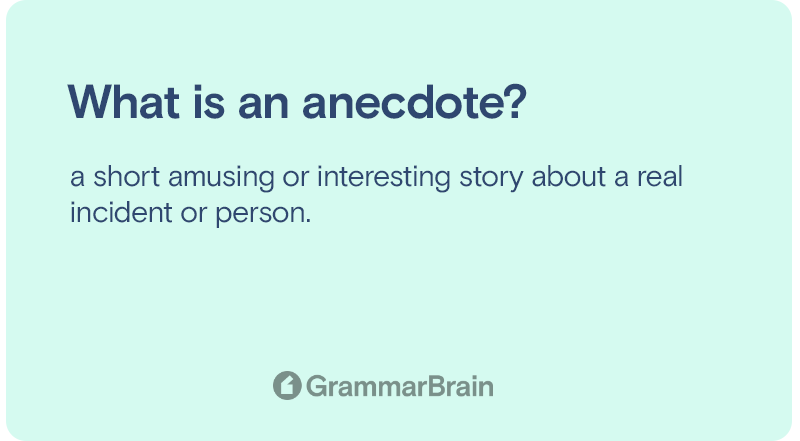
What is an anecdote?
Anecdotes are stories that are self-contained and brief. The majority of anecdotes focus on a single, straightforward theme or incident. They can be factual or made up or can be a real incident mixed with some embellishment.
Anecdotes can be conveyed using different tones , ranging from lighthearted jokes to grave warnings. They also typically concentrate solely on one character.
| Device | Definition |
| Anecdote /ˈanəkˌdōt/ ( ) | a short amusing or interesting story about a real incident or person. |
Purpose of an anecdote
Anecdotes can be used for a number of purposes. Anecdotes , when used in both nonfiction and fiction as a literary device, have a greater significance.
For instance, some anecdotes provide the readers with a better grasp of a character’s background or motivations by describing them in a manner that doesn’t match the central narrative.
They are used to introduce backstory or character information. Authors usually use them to share some past story of their character usually to provide substance and intrigue.
They also offer a good way to fill in plot holes in the narrative or to impede its flow. And are typically used in real life to convey an important message in a lighthearted way rather than a direct explanation.
Good anecdotes use rhetoric to their advantage. Sentimental language is usually used in inspirational anecdotes to touch the heart of the listener or reader.
Similarly, authors may use profanity or slang in humorous anecdotes to make them appear even funnier.
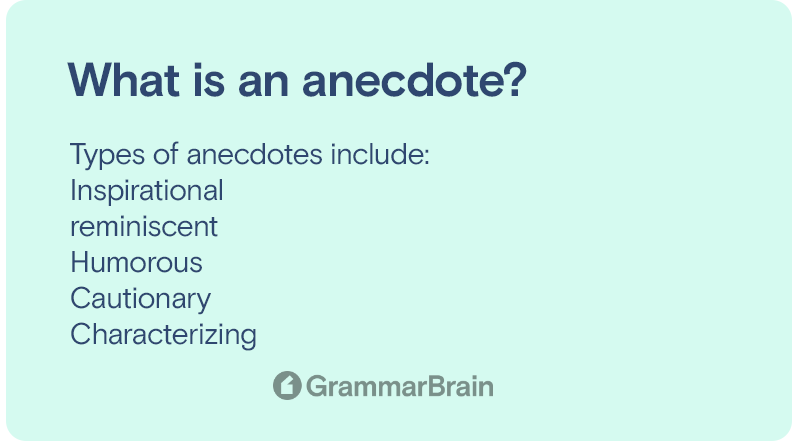
Anecdotes: The different types
There is no formal classification of anecdotes . But they can be broadly divided into different groups based on the purpose they serve.
These include:
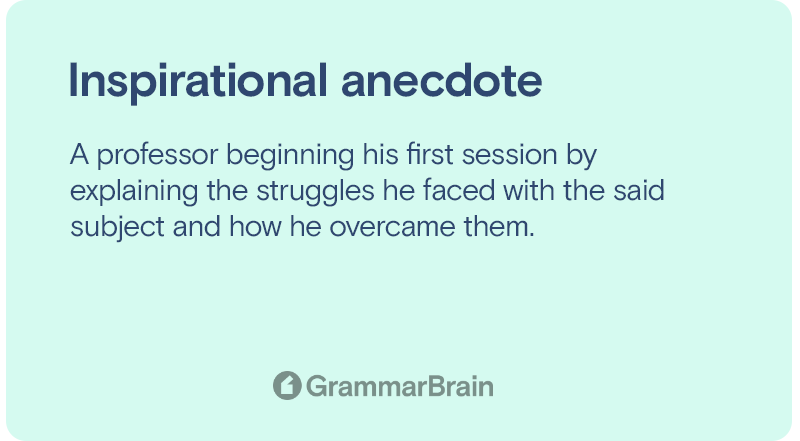
Inspirational or motivational anecdotes
Anecdotes can be used by elders or experienced people to motivate youngsters by describing the challenges they have faced in their lives and how they are willing to assist them. Inspirational anecdotes are a powerful writing technique that can be used to evoke specific emotions in the reader.
This is an especially effective technique in emotional and persuasive writing . Inspirational stories frequently center on extraordinary experiences that occurred to regular individuals that the listener or reader can relate to.
Writers frequently use motivational stories to emotionally appeal to their readers. These stories can convince the readers that difficult times will pass after some time and better days are ahead.
Some examples include:
- A professor beginning his first session by explaining the struggles he faced with the said subject and how he overcame them.
- A dog shelter volunteer recounting stories of the successful rehoming of several rescue animals over the years and how they, with the help of families, found many dogs their forever homes.
- A manager recounting his early days at the company and the difficulties he faced with a group of new recruits on their induction day.
- Members of a youth organization telling stories to a group of young people about the volunteer work they have done over the years and how it changed their lives and the lives of those they helped.

Reminiscent anecdotes
The majority of anecdotes focus on the past. In anecdotes, people usually look back fondly on special periods of their lives and share the happiness of those times with others. These fond tales usually build an idealized view of the past by evoking feelings of longing or nostalgia.
But this reminiscing may not always be happy. Sometimes depressing memories can creep up in the stories, giving rise to a feeling of melancholy or despair.
- A father recounts to his daughter a trip his family took when he was a child.
- A kid shares an account of his best vacation to Disney Land during a discussion about theme parks.
- A senior doctor shares his favorite experiences in the ER with the new interns.
- A war veteran recount his experiences during deployment of how war can change common people with young soldiers.

Humorous anecdotes
Anecdotes started out as stories that people would share in groups to amuse one another. Writers now use jokes to convey a much more complex topic in a lighthearted way. A humorous anecdote can be used to cheer people up following a significant or dramatic plot development in a story.
Similarly, it can also provide audiences or readers with a brief diversion from the main plot and give them something to laugh about.
Some examples of funny anecdotes include:
- A boy telling a humorous story to his friends while sitting around a campfire on a school trip.
- A father telling his kids about the funny pranks he did with his brother during his childhood days.
- A professor starting the first day of college by telling a funny story that happened during his college days.
- A speaker starting his address with a funny incident that happened to him.
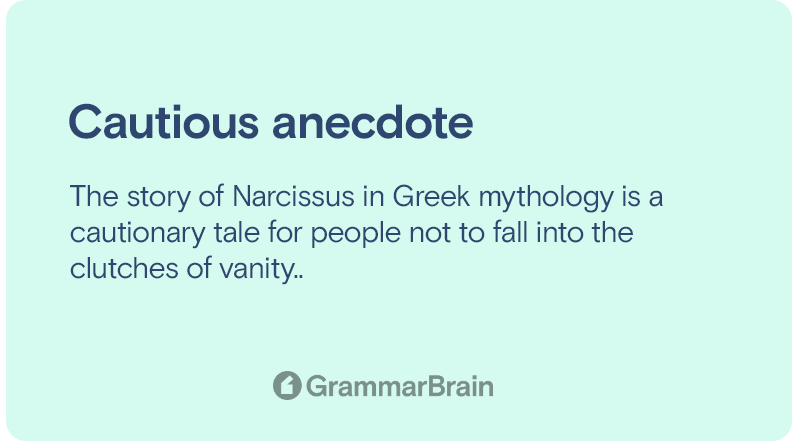
Cautionary anecdotes
Anecdotes are always concise and focused. This makes the perfect tool for imparting an important lesson or message to the readers. Such “cautionary tales” often feature irresponsible or flawed individuals who suffer punishment or unfavorable outcomes by doing the wrong thing.
Religious parables, fairy tales, and historical myths all use cautionary anecdotes to inspire people to act morally by illustrating the consequences of doing otherwise.
- The story of Narcissus in Greek mythology is a cautionary tale for people not to fall into the clutches of vanity.
- The fairy tale “Little Red Riding Hood” is a cautionary tale warning kids about the dangers of talking to strangers.
- Shakespeare’s “Macbeth” is a cautionary tale against power, greed, and mayhem.
- Before giving a presentation on alcohol addiction, a speaker can start with a story that details the bad effects alcohol had on the lives of someone like himself.
Characterizing anecdotes
Anecdotes are frequently employed in literature to give characters more depth by highlighting aspects of their personalities or prior experiences that don’t directly relate to the central story.
This strategy is also applied in real life, frequently with historical figures and celebrities to emphasize specific qualities or traits.
Some of these anecdote examples include:
- Everybody is familiar with the story of Alexander and his encounter with the famous Gordion Knot. It was said that whoever could untie this knot would control Asia. For many ages, kings and princes flocked to Phrygian Gordion in an effort to untangle this intricate knot, but all of them failed. When Alexander heard about the knot, he rode to Phrygian Gordium, pulled out his sword, and cut the knot. There were no instructions on how to unravel the knot. This meant that Alexander did nothing wrong by cutting it rather than untying it. This anecdote demonstrates the way Alexander approaches a problem and his capability to think outside the box. These qualities were what made him a great conqueror in the future.
How to write good anecdotes
Writing anecdotes isn’t difficult. Anecdotes can be used in a myriad of forms of writing, including general fiction and non-fiction works, speeches, essays, and even school or college works.
Using anecdotes while writing improves the writer’s skills and makes the text engaging. There are some tips writers can use to craft excellent anecdotes.
Have a clear objective or purpose in mind
Many writers think that, despite having fewer words, crafting anecdotes takes more effort and time. Sometimes the writers may need to express their thoughts in a limited number of words. All these can make using anecdotes a bit difficult.
The first step to crafting a good anecdote is to define the purpose or intention of the text, whether it is to make the reader laugh or to give some serious advice .
After this objective is clear, writers can design their anecdotes around it.
Begin with the action
Essays usually begin with an introduction that gives the reader an idea about the topic that is about to be discussed in detail. But writers can forgo this by using anecdotes and jumping directly into the story.
When compared to boring introductory paragraphs, using quirky anecdotes, in the beginning, can easily hold the attention of the readers.
Many famous fiction writers, like Malcolm Gladwell, use this technique to capture the attention of readers.
Create a short anecdote
An anecdote is brief, so it is important to stay true to its purpose and not include unnecessary details. Rereading the writing while viewing it from the perspective of another person can help writers identify unnecessary details in the text.
The target audience must always be taken into account. For example, while employing scientific terminology, writers should be prepared for the possibility that some listeners won’t comprehend what they’re saying.
It’s best to choose the alternative collocation because further explanation will just make things worse.
Include a clear conclusion
The writers should make sure that the readers will be able to tell when the anecdote is ending. Writers can use terms like “and that’s what happened” to indicate the end of anecdotes. The ending of anecdotes is heavily dependent on the message they put forth.
Anecdotes are typically one or two paragraphs long at most. Stories are much longer than anecdotes. When writers create stories, they have far more room for detail and put more work into making the readers feel immersed in the narrative.
Anecdotes, as they are meant to be brief, typically center on a single main character, with very little information about supporting characters.
The narratives are also similarly kept simple by typically concentrating on just one conflict or subject.
Anecdotes rely heavily on rhetoric to create the desired mood. Experienced writers who use anecdotes focus on the language they use to ensure it reflects the tone they are striving for.
Anecdotes typically have a start, middle, and conclusion, like any other form of narrative. The characters and overarching ideas are introduced at the start, the conflict or action of the narrative is presented in the middle, and everything is resolved at the conclusion.
The structure of anecdotes is similar to that of stories, but everything is considerably shorter.
Anecdotes are by nature brief and straightforward; therefore , they typically follow a more rapid pace with fewer specifics.
Both types are considered short stories. When referring to short stories, they are the same as a brief tale or short narrative.
- Merriam Webster – anecdote – Definition
- Wikipedia – Anecdote
- Literary Terms – Anecdote
- Cambridge Dictionary – anecdote
Inside this article
Fact checked: Content is rigorously reviewed by a team of qualified and experienced fact checkers. Fact checkers review articles for factual accuracy, relevance, and timeliness. Learn more.

About the author
Dalia Y.: Dalia is an English Major and linguistics expert with an additional degree in Psychology. Dalia has featured articles on Forbes, Inc, Fast Company, Grammarly, and many more. She covers English, ESL, and all things grammar on GrammarBrain.
Core lessons
- Abstract Noun
- Accusative Case
- Active Sentence
- Alliteration
- Adjective Clause
- Adjective Phrase
- Adverbial Clause
- Appositive Phrase
- Body Paragraph
- Compound Adjective
- Complex Sentence
- Compound Words
- Compound Predicate
- Common Noun
- Comparative Adjective
- Comparative and Superlative
- Compound Noun
- Compound Subject
- Compound Sentence
- Copular Verb
- Collective Noun
- Colloquialism
- Conciseness
- Conditional
- Concrete Noun
- Conjunction
- Conjugation
- Conditional Sentence
- Comma Splice
- Correlative Conjunction
- Coordinating Conjunction
- Coordinate Adjective
- Cumulative Adjective
- Dative Case
- Declarative Statement
- Direct Object Pronoun
- Direct Object
- Dangling Modifier
- Demonstrative Pronoun
- Demonstrative Adjective
- Direct Characterization
- Definite Article
- Doublespeak
- Equivocation Fallacy
- Future Perfect Progressive
- Future Simple
- Future Perfect Continuous
- Future Perfect
- First Conditional
- Gerund Phrase
- Genitive Case
- Helping Verb
- Irregular Adjective
- Irregular Verb
- Imperative Sentence
- Indefinite Article
- Intransitive Verb
- Introductory Phrase
- Indefinite Pronoun
- Indirect Characterization
- Interrogative Sentence
- Intensive Pronoun
- Inanimate Object
- Indefinite Tense
- Infinitive Phrase
- Interjection
- Intensifier
- Indicative Mood
- Juxtaposition
- Linking Verb
- Misplaced Modifier
- Nominative Case
- Noun Adjective
- Object Pronoun
- Object Complement
- Order of Adjectives
- Parallelism
- Prepositional Phrase
- Past Simple Tense
- Past Continuous Tense
- Past Perfect Tense
- Past Progressive Tense
- Present Simple Tense
- Present Perfect Tense
- Personal Pronoun
- Personification
- Persuasive Writing
- Parallel Structure
- Phrasal Verb
- Predicate Adjective
- Predicate Nominative
- Phonetic Language
- Plural Noun
- Punctuation
- Punctuation Marks
- Preposition
- Preposition of Place
- Parts of Speech
- Possessive Adjective
- Possessive Determiner
- Possessive Case
- Possessive Noun
- Proper Adjective
- Proper Noun
- Present Participle
- Quotation Marks
- Relative Pronoun
- Reflexive Pronoun
- Reciprocal Pronoun
- Subordinating Conjunction
- Simple Future Tense
- Stative Verb
- Subjunctive
- Subject Complement
- Subject of a Sentence
- Sentence Variety
- Second Conditional
- Superlative Adjective
- Slash Symbol
- Topic Sentence
- Types of Nouns
- Types of Sentences
- Uncountable Noun
- Vowels and Consonants
Popular lessons

Stay awhile. Your weekly dose of grammar and English fun.

The world's best online resource for learning English. Understand words, phrases, slang terms, and all other variations of the English language.
- Abbreviations
- Editorial Policy

Anecdote Essay
Anecdote essay generator.
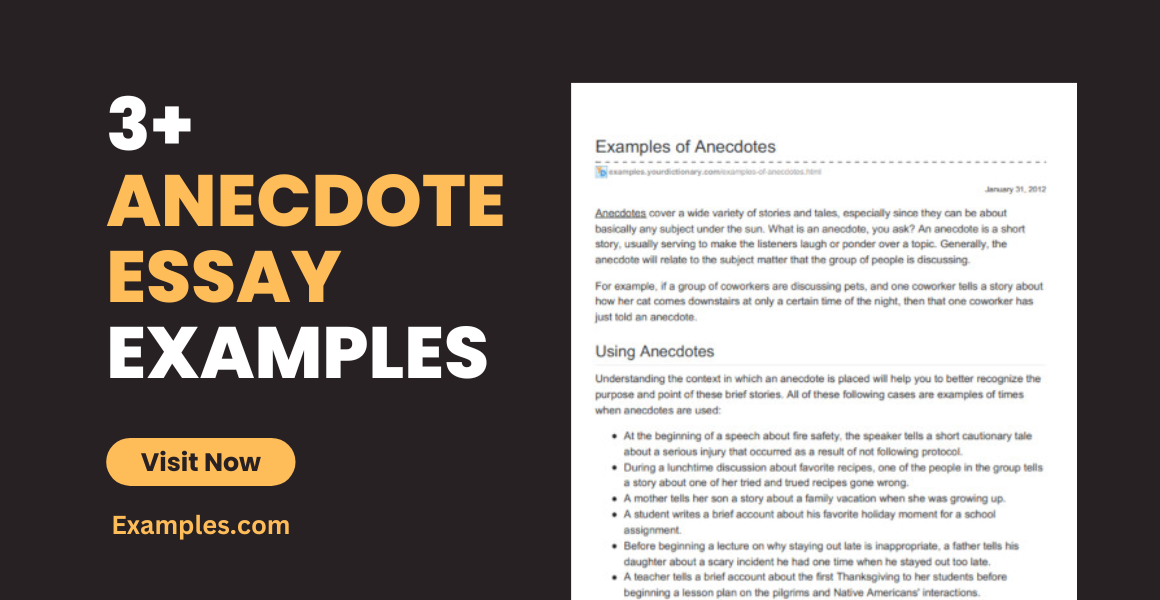
Anecdotal essays are common among colleges. It is useful when you want to have a bond between you and the readers. Through anecdotes, the audience will be able to engage themselves in your work. The question is “how are you going to create good anecdotal essays?”. Always remember that like any other essays , anecdotal essays also follow a specific format. In this article, you will be able to know details about the nature and structure of an anecdotal essay.
3+ Anecdote Essay Examples
1. anecdote literature essay.

Size: 97 KB
2. Example of Anecdote Essay
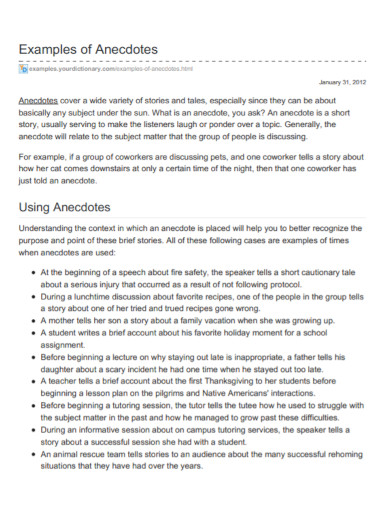
Size: 59 KB
3. Morality Anecdote Essay
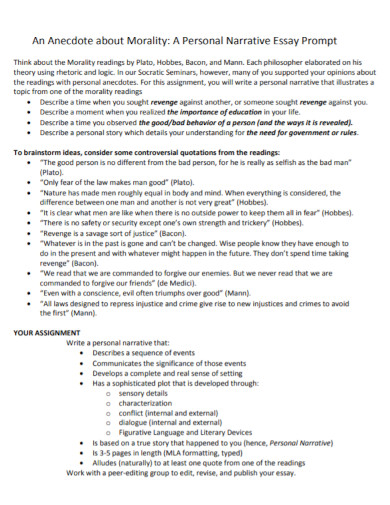
Size: 369 KB
4. Anecdote Essay Template
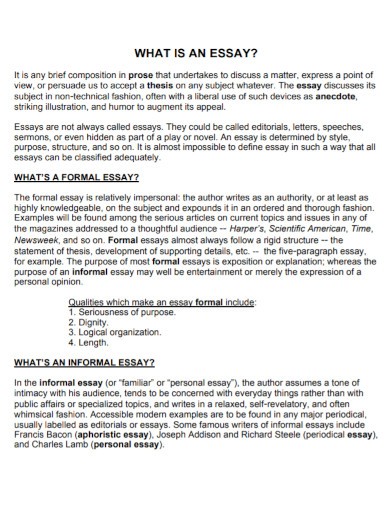
What is an Anecdote?
An anecdote is a short account of a specific person or a real occurrence. They make conversations that are considered to be personal. They are placed for the purpose of making the readers entertained.
An example of an anecdote would be: “When I was a kid, I used to have a dog who happens to be my best friend. I couldn’t imagine my life without him.”
How to Use Anecdotes in Essays?
- To have a very good message in your story , use your past experience as anecdotes.
- Venture out into the real world.
- Start a new story when you are being placed with another inspiration.
- If you have diaries, you may use it to connect together and make a good storyline.
- Let your stories speak for themselves.
Here are some examples of anecdotal essays that you may want to read:
“Kendall Hill describes how he was a “nerd” at school: he wishes it was easier to be “different”. He states, “if only it were easier to be different in this country. Back then our education system – and, by extension, most teachers and students – rejected anything unconventional”. Refer “Habitual cruelty: maybe the bullies get screwed up the most”, The Age, 19/6/11).
When the TV series of Alex Haley’s slave epic Roots was first broadcast in Australia a few decades ago, my high school tormenters had a brilliant idea. We could play Roots at school the next day.
“You can be Kunta Kinte!” my nemesis hooted, his eyes flashing evil mischief. “And the rest of you can go home and make willow whips.”
Electric excitement rippled through the group. Me? I thought I might cry.
The episode sums up the hell of high school for me – falling into a poisonous group that terrorised other students but, mostly, terrorised me. Soccer matches where I became the ball, kicked around until I was coated in mud like a choc-dipped loser. Threats hissed through clenched teeth to force two unwilling combatants, one of them always me, to brawl at lunchtime for the school’s entertainment. Every student on every bus chanting insults at me at home time.
And they say school days are the best of the your life.”
Linda Duberley recounts her despair at the fact that her son, Connor, was ruining his life owing to his gaming addition. (See “My son was a cyber addict – hooked on fantasy and sci-fi games” in The Age .) “For three years, Connor played truant, failed exams and shut himself away from people to create a new personality in his electronic universe.”
Duberley recounts: “To me, the problem seemed to be school; Connor was truanting. He was tired and stressed. So, I cut back my work as a media consultant to be around more at home. But he found new ways to sneak home from school, only now he had to be even more surreptitious to avoid me. Then, at a parents’ evenings, two of his teachers were clearly surprised to see me – they thought that he had left the school. That Christmas, his father took Connor’s younger brother and sister away so he and I could be alone together and talk. I was optimistic. But shortly after that, on just the second day of the new term, I found Connor hiding in the bathroom, having sneaked back into the house. In fact, he turned up at home several times that week, once having gone missing for so long that I called the police. That time, I eventually found him hidden, wrapped up in a duvet inside a cupboard.”
Writing anecdotes and real-life examples. (2014). English Works.
How do we formulate ideas when creating an anecdote essay.
You may start by using your own experiences to tell a story and then gather your ideas and start producing to make it a wholesome anecdote essay.
How long should an anecdotal essay be?
Anecdotal essays are like any other essays that contain two or more paragraphs.
When do we use anecdotes?
You may use anecdotes when you give personal perspectives or make people feel something like extreme happiness or sadness depending on the story.
The use of anecdotes makes your story more valuable. They can be used anywhere especially in telling a story about a specific person or an experience.
Text prompt
- Instructive
- Professional
Write an anecdote essay about a time you overcame a challenge.
Describe in an anecdote essay a moment that changed your perspective on life.

How to Write an Anecdotal Essay

How to Teach Middle School Students to Write a Thesis Sentence
Although the concept of an anecdotal essay sounds simple enough--you are, after all simply telling a story--writing one can be quite challenging. As with any other type of writing assignment, the essay should capture and hold your reader's interest. Fortunately, if you take time to structure the paper properly, your anecdotal essay can be fun to write and more importantly, fun to read.
How to Write an Ancedotal Essay
Come up with a list of ideas for your anecdotal essay. Think back to an important event in your life or other personal experiences that have affected you.
Pick one story to use as the basis for your anecdotal essay. Discuss your ideas with a friend, teacher or peer and find out which story appeals to him or her. Hearing someone else's opinion can help you select the most interesting subject for your paper.
Determine the theme of your essay. Think about your reason for writing the story---do you want to make your readers laugh or do you want your story to offer insight about a serious issue?
Tell your story in three to four body paragraphs. Because this is the most important part of your story, you should spend the most time on this section. Make sure your writing is clear, grammatically correct and structured logically.
Write an introduction for your essay. Because it's the beginning of your essay, make sure your introduction uses an appropriate tone that prepares your readers for the story you're telling. For example, if you're telling a funny anecdote, the introduction should make your reader laugh. On the other hand, if your story is serious, your introduction should be more formal.
Write your conclusion. This paragraph should sum up your reasons for writing the essay and offer any additional thoughts on the subject.
Proofread your essay, checking for spelling and grammatical errors as well as structural issues. If possible, have someone else look over your paper as well.
Try writing your paper in the first-person point of view ("I"). This style is especially effective in anecdotal essays and can often be easier to write than the standard third-person point of view.
Consider your audience. Who will be reading your story? Is the subject appropriate for your readers?
Reading your essay out loud can help you identify errors and inconsistencies in your story that may not be as apparent during your proofreading.
Vary your sentence length. Although an abundance of long, complex sentences can frustrate your readers, consistently short, simple sentences can also bore them. As a result, it's best to use a mixture of sentence lengths.
Related Articles

How to Write a Controlling Idea Essay

What Are the Five Parts of an Argumentative Essay?
How to write a rebuttal speech.

How to Write a Descripitive Paragraph

How to Write an Essay Explaining a Concept
How to write an essay with a thesis statement.

How to Write a Thesis Statement for a Critical Lens Essay

How to Write a Speculative Essay
- Try writing your paper in the first-person point of view ("I"). This style is especially effective in anecdotal essays and can often be easier to write than the standard third-person point of view. Consider your audience. Who will be reading your story? Is the subject appropriate for your readers? Reading your essay out loud can help you identify errors and inconsistencies in your story that may not be as apparent during your proofreading. Vary your sentence length. Although an abundance of long, complex sentences can frustrate your readers, consistently short, simple sentences can also bore them. As a result, it's best to use a mixture of sentence lengths.
Shell James Saras is a creative hybrid that has spent his career in media design and development. With a strong industry track record in advertising technology, web design/development and managing creative talent; he also writes articles for various online channels in need of relevant content.

How to Write an Anecdote and Why Stories Bring Your Nonfiction to Life
You have a message to share with the world, but so far, people don’t seem interested.
Are you wasting your time?
You are if your nonfiction fails to engage an agent or publisher.
You may have forgotten the importance of storytelling — yes, even in nonfiction.
Adding stories to your nonfiction :
- Hooks your reader from the get-go
- Transforms dull writing
- Makes your point quicker and more clearly than mere narrative summary
People are drawn to stories. I know I am.
Which would more engage you, an essay on how and why to do something , or an anecdote that begins, “Joe had a problem. He…”?
Stories make concepts more relatable. That’s why we tell children the tale of “The Boy Who Cried Wolf,” rather than simply saying, “Don’t lie.”
Anecdotes can be true or fictitious — whichever best serves your purpose. Just be sure to make clear to the reader which is which. That’s as simple as how you begin your anecdote. You should be able to tell immediately which of the following are true or not:
My sister-in-law faced a dilemma with her daughter recently…
Consider the father of, say, two preschoolers. He…
Several years ago, I…
If a boy being raised in a broken home…
- 6 Tips for Writing Killer Anecdotes
1) Study the best
Skim nonfiction books you love, keeping an eye out for anecdotes.
- The Butterfly Effect and The Traveler’s Gift by Andy Andrews
- Outliers by Malcolm Gladwell
- Blue Like Jazz by Donald Miller
2) Study fiction writing
Writing anecdotes requires fiction techniques:
- Use action verbs and go light on adjectives and adverbs
- Even a brief story needs a main character
- That character (real or imagined) must have a clearly defined challenge
- Use dialogue , setting , conflict , tension , drama, action — yes, even in a very brief anecdote
That will make your message come alive to your reader.
3) Start with a bang
You can spend years on a nonfiction book and get fewer that five minutes of an agent’s or publisher’s time. Sadly, they can often tell by page two whether they’re interested.
That’s why you must learn to hook them from the get-go.
Consider this anecdote from Anne Lamott’s Bird by Bird :
“Thirty years ago my brother, ten years old at the time, was trying to get a report on birds written that he’d had three months to write. It was due the next day. He was at the kitchen table close to tears, surrounded by binder paper and pencils and unopened books on birds, immobilized by the hugeness of the task. My father sat beside him, put his arm around my brother’s shoulder, and said, ‘Bird by bird, buddy. Just take it bird by bird.'”
Notice that the first sentence both sets the scene and immediately introduces the problem: a massive report due the next day.
Another writer might have started by describing the setting and establishing the family dynamic. Lamott starts at the moment of crisis.
An anecdote gives you a much better chance of impressing a publisher than starting with observations or persuasion.
4) Avoid preaching
Imagine you’ve confided to two friends that you’ve run into financial trouble.
The first says, “Here’s what you need to do. Start by…”
The second drapes an arm around your shoulder and says, “I was in your place once. Let me tell you what I learned and how I got out of it.”
Which friend are you most likely to listen to?
I call that second approach the Come-Alongside Method. It avoids preachiness and allows the reader to get the point without having the spotlight shone in their face. When considering an anecdote, think reader-first. How will it best benefit him?
5) Go easy on description
Show, don’t tell . Rather than writing, “It was cold,” show your character hunching their shoulders against the wind.
Anton Chekhov said, “Don’t tell me the moon is shining; show me the glint of light on broken glass.”
Less is more. This is especially important when using only a couple of sentences to tell a story that supports your point.
6) Cut to the bone
Become an aggressive self-editor .
- Omit needless words
- Avoid subtle redundancies such as “He shrugged his shoulders” (What else would he shrug?)
- Look for words that can be cut without changing the meaning, like up, down, very
M ake every word count.

Are You Making This #1 Amateur Writing Mistake?

Faith-Based Words and Phrases

What You and I Can Learn From Patricia Raybon

Before you go, be sure to grab my FREE guide:
How to Write a Book: Everything You Need to Know in 20 Steps
Just tell me where to send it:

Enter your email to instantly access my ultimate self-editing checklist.

In order to continue enjoying our site, we ask that you confirm your identity as a human. Thank you very much for your cooperation.
Jump to navigation
- Inside Writing
- Teacher's Guides
- Student Models
- Writing Topics
- Minilessons
- Shopping Cart
- Inside Grammar
- Grammar Adventures
- CCSS Correlations
- Infographics
Get a free Grammar Adventure! Choose a single Adventure and add coupon code ADVENTURE during checkout. (All-Adventure licenses aren’t included.)
Sign up or login to use the bookmarking feature.
Using Anecdotes in Formal Writing
Minilesson print.

An anecdote is a brief story used to make a larger point. Anecdotes can add a storytelling touch to your explanatory and persuasive writing—connecting your ideas to real life and real people. Here are some ways you can use anecdotes in the main parts of formal writing.
Beginning: To Introduce a Topic
In the ocean, two hungry dolphins pick up speed when they spot a school of flying fish. Sensing danger, the fish dart ahead. Soon they are cruising through the deep blue water at 20 miles an hour. As the dolphins get closer, the flying fish break through the surface, spread their fins like wings, and take off. Amateur explorers have called them “dragonflies of the deep,” but flying fish are most definitely fish.
Middle: To Support an Idea
The bleachers in the gym are unsafe. Some of the boards are cracked, which makes them hard to navigate. Just last week, a student was walking up the bleachers when she tripped on a crack, spilled her popcorn, and banged her wrists. She wasn't seriously hurt, but the next person who trips on the bleachers might not be so lucky.
Ending: To Make a Final Point
On the third turn of the 111th lap at Bellville Speedway, racer Keith Sweat lost control of his vehicle and slammed into a new shock-absorbing wall. After a caution flag cleared the track, Sweat unbuckled his new head and neck braces and walked out of his mangled race car without so much as a scratch or limp. At least for today, the new mandatory safety measures triggered by a year-old tragedy fulfilled their promise: to keep drivers safe.
Your Turn Identify an anecdote in each of the following stories. Then choose one of the anecdotes and follow a similar pattern to create an anecdote about a topic of your choosing. (Click on the links to find each story.)
- " Hang Up and Drive "
- " Save the Elephants "
- " 100 Years Old. 5 World Records. "

From page 101 in Writers Express
Teacher Support:
Click to find out more about this resource.
Standards Correlations:
The State Standards provide a way to evaluate your students' performance.
- 110.6.b.11.B.ii
- 110.6.b.12.B
- LAFS.4.W.1.2
- 110.6.b.11.B
- 110.6.b.12.A
- LAFS.4.W.1.3
- 110.7.b.11.B.ii
- 110.7.b.12.B
- LAFS.5.W.1.2
- 110.7.b.12.A
- LAFS.5.W.1.3
- 110.22.b.10.B.ii
- 110.22.b.11.B
- LAFS.6.W.1.2
- 110.22.b.10
- 110.22.b.11.A
- LAFS.6.W.1.3
- 110.23.b.10.B.ii
- 110.23.b.11.B
- LAFS.7.W.1.2
- 110.23.b.10
- 110.23.b.11.A
- LAFS.7.W.1.3
- 110.24.b.10.B.ii
- 110.24.b.11.B
- LAFS.8.W.1.2
- 110.24.b.10
- 110.24.b.11.A
- LAFS.8.W.1.3
- 110.36.c.10.C
- 110.36.c.9.B.ii
- 110.37.c.10.C
- 110.37.c.9.B.ii
- LAFS.910.W.1.2
- LA 10.2.1.b
- LA 10.2.1.c
- LA 10.2.2.b
- 110.36.c.10.A
- 110.37.c.10.A
- LAFS.910.W.1.3
- LA 10.2.2.a
- 110.38.c.9.A
- 110.38.c.10.B
- 110.39.c.9.A
- 110.39.c.10.B
- 110.38.c.5.C
- LAFS.1112.W.1.2
- LA 12.2.1.b
- LA 12.2.2.a
- LA 12.2.2.b
- 110.38.c.10.A
- 110.39.c.10.A
- LAFS.1112.W.1.3
© 2024 Thoughtful Learning. Copying is permitted.
k12.thoughtfullearning.com
Related Resources
All resources.
- How to Engage Your Students with Shared Inquiry
- Correcting End Punctuation
- Correcting Capitalization 1
- Using Commas in a Series
- Using Commas in Dates and Addresses
- Learning Grammar, Usage, and Punctuation
- Learning Grammar, Usage, and Punctuation (At-Home)
- Refining Grammar, Usage, and Punctuation
- Starting Grammar Skills (At-Home)
- Starting Grammar Skills
- All Write SkillsBook
- All Write SkillsBook Teacher's Edition
- Write on Course 20-20 SkillsBook (6)
- Write on Course 20-20 SkillsBook (6) Teacher's Edition
- Write on Course 20-20 SkillsBook (7)
Essay Writing Guide
How To Start An Essay
Last updated on: Jun 28, 2024
Learn How to Start an Essay Effectively with Easy Guidelines
By: Nova A.
13 min read
Reviewed By: Melisa C.
Published on: Feb 12, 2019

Are you assigned to write an essay assignment for your school? Are you staring at the blank screen, not knowing where to start?
Essay writing can be tough, and knowing how to start an essay effectively is highly important.
Why? Because “the first impression is the last impression?”
Similarly, the impression you make on the reader with your introduction sets the tone for the rest of the text. This makes them decide whether or not they want to invest their time reading it further. So starting effectively is a highly critical part of any paper or essay.
If you are stuck at this stage and unsure how to begin, then this is just the right guide for you.
Let’s dive in!

On this Page
When writing an essay, you must know that there is no hard and fast rule for starting it. There are four main types of essays: argumentative essay , persuasive essay , descriptive essay , and expository essay .
Similar to the different types of essays, there are several different ways to start an essay. However, the most commonly followed way is the hamburger essay method.
This method is also known as the introduction, body, and conclusion. Where the hamburger buns are the introduction and the conclusion. And the main ingredients are the body paragraphs of the essay.
Follow this method to know how to start an essay.
How to Start an Essay Introduction
“How to Start an Introduction for an Essay?”
The introductory paragraphs of any piece of writing hold the most importance. They help to grab the reader’s attention and make them decide whether or not they should invest their time. Similarly, the introduction acts as a roadmap and sets the tone for the content of the rest of the essay.
As we pointed out earlier, there isn’t a set way to start an essay. But the one thing you need to be mindful of is that your introduction should be catchy as well as informative.
To make your work interesting and attract the reader’s attention with the opening line, you must use a hook sentence.
1. Hook and Engage Your Readers
An essay hook is an opening sentence used as an attention grabber for the reader, to make them read further.
However, a hook sentence doesn’t substitute for the introduction. Instead, it opens your essay in an interesting manner. There are different types of hooks that you can use. For instance, you can begin your essay with a quote or by asking some rhetorical questions.
Depending upon the nature and topic of your essay, you can use any of the following hooks:
- Personal story
- Common misconceptions
For example, if you are writing a literary essay on Anna Karenina, you start by posing a question like,
“Do you think Anna would still be in love with Alexei if she wouldn’t have committed suicide”? And then answer it in your essay.
Can’t write engaging opening lines for your essay? Here are some interesting hook examples to give you an idea.
2. Provide Some Background Information
After you have hooked the reader, the next step is to introduce the topic to your reader. Inform them about the main idea of your essay and present background information to make your topic clear.
However, make sure not to bombard the reader with extra information at this stage. You don’t want them to get overwhelmed with excess information and stop reading further. Depending upon your essay topic, your background information may include:
- An outline addressing what are you debating about
- Definition of key terms
- Summary of your research topic or theory
- Any historical, social, or geographical context.
Just give enough information to familiarize them with the whole idea of making it easier to understand. When looking for information on your topic, only use credible and authentic sources.
Performing exhaustive research before beginning writing is an inevitable part of the essay writing process.
3. Add a Thesis Statement
The last component of an essay introduction is a thesis statement. The thesis statement summarizes the entire concept and states the main objective of the essay.
The purpose of the thesis statement is to present your main claim about the topic.
A thesis statement should be arguable and not based on facts that the reader already believes in. Your readers want to read something interesting and engaging. And the only way to do that is to provide them with some new and arguable information.
A good thesis statement is arguable, defendable, as well as informative. You can learn more here about writing a thesis statement , along with examples.
Once you have successfully started your essay introduction, the next section is the body.
4. Define Your Essay Structure
Ending the introduction by signposting what will be covered in each part can give your reader a clear sense of where they are headed.
It is helpful to keep it concise and not too wordy with unnecessary information that would take away from this goal.
The first part of this essay discusses the life and works of Louis Braille, who created a system for blind students to read using their fingers. It then describes how he struggled with his invention at first but was able to gain acceptance within schools around Europe by 1850. Finally, it explores some effects that were brought about after its widespread use, such as increased independence among blind people and improved literacy rates in general populations across countries where they live today. |
5. Check & Revise Your Essay
A good way to write your introduction paragraph is by waiting until the end of the writing process.
You learn more as you research, and this can change how you want to make an argument for your paper. So it’s best not to start right away with the first thing that comes out because it may be wrong later on.
After writing the essay body and conclusion, you should return to your introduction. Compare the flow of your information. Also, check if your thesis statement in the introduction coincides with justifications in your body and conclusion paragraphs.
After this, also go through your essay to figure out the grammatical mistakes and sentence structure. These seem like minor mistakes, but they can cause great damage to the overall grading of an essay.
How to Start an Essay Body?
“How to Start a Paragraph in an Essay?”
The body paragraphs of the essay hold the main content of the essay. Here you explain your point of view and present the main ideas.
The body is typically made up of three paragraphs. However, they can vary depending on the complexity of the topic and your teacher’s instructions.
The one thing that stays constant regardless of the different essay topics is that each paragraph starts with a topic sentence. The topic sentence explains the main idea of a particular paragraph, followed by the explanation and supporting evidence.
You can use factual evidence to prove your claim or different examples, statistics, and details from the text itself. All these paragraphs should work together to link back to your thesis and to prove it.
How to Start an Essay Conclusion?
The last section of an essay is the conclusion, and this is where most students go wrong. They start it abruptly and leave the reader confused without providing sufficient information.
When writing the conclusion for your essay, remember that this will be the last thing you leave your reader with. So, don’t make it vague. Use this opportunity to restate the thesis and summarize the main points.
Remind the reader why your stand on the particular topic was correct. Avoid introducing any new information at this stage.
While we have covered everything about starting your essay, to learn more about the content, here is a complete essay format .
How to Start an Argumentative Essay?
An argumentative essay is different from other kinds of essays as the writer uses it to prove his point and convince the readers of his point of view.
It clearly outlines a point, the reasoning behind it, and evidence for the reader to understand your position.
Good argumentative essays should have these key elements:
- A thesis statement that reflects what you are trying to argue or convey.
- Reasonable supporting points with examples/logic backing them up.
- Evidence from experts who can prove your claims.
Below are the steps to start an argumentative essay.
1. Create an Outline
Creating an outline is the very first step of beginning your essay, whether it is an argumentative or any other essay. It will help you in maintaining a clear focus and staying close to the main theme and topic of the essay.
2. Decide the Information You will Add in the Introduction.
Your first paragraph should introduce the topic of your essay, provide background information, and outline what evidence you will present.
In addition, this part of your paper needs a thesis statement that clearly states why readers should care about the issue at hand.
3. Formulate the Thesis Statement
This is part of your first paragraph. It summarizes the main point and claims in a concise manner, without repeating any information from the input directly.
4. Outline the Main Section of the Essay
Decide about the information that you will add and explain in the main section of the essay. Instead of having everything in your mind only, it is important that you write down everything and stick to the plan.
5. Outline the Conclusion
Make a complete and workable outline for your essay’s conclusion. Make points of the things that you will discuss in your essay’s conclusion and stay close to them.
In simple terms, make an outline of each section and make sure that you follow it completely and properly.
How to Start an Application Essay?
The college essay is not the same kind of essay that you write for your high school English teacher, so it doesn't have to include a typical intro with a thesis statement.
Many students are unaware of this fact. Just as you want to prepare answers for your college interview, here are some ways to start your essay on an engaging and interesting note.
- Start with a question.
- Begin your essay with a bold and striking statement.
- Use an engaging and relevant quote.
- Begin from the middle of the events.
- Speak with the reader directly.
Using these ways will help you write an essay that stands out from the competition.
Different Ways To Start an Essay
Now you know the essential elements to consider when starting to write your essay. Following are some of the different ways that you can consider starting your academic essay.
How to Start an Essay With a Question?
Starting an essay with an intriguing question is one of the easiest and most effective ways to get the attention of your readers.
In this way, the reader will think about the essay subject and will want to find out how the author has answered the question.
"What is the appeal of pieces of jewelry? For what reason would anybody put a bonus around their neck and afterward contribute it with unique importance? An accessory doesn't bear the cost of warmth in a chilly climate, similar to a scarf, or assurance in battle, similar to networking mail; it just finishes. We may say it acquires significance from what it encompasses and sets off, the head with its especially significant material substance, and the face, that register of the spirit. At the point when picture takers talk about the manner by which a photo diminishes the truth it addresses, they notice not just the entry from three aspects to two, yet in addition the determination of a point that inclines toward the highest point of the body rather than the base, and the front rather than the back. The face is the gem in the crown of the body. Thus we give it a setting." (Emily R. Grosholz, "On Necklaces." Prairie Schooner, Summer 2007) |
How to Start An Essay With a Quote?
The internet has made it easy for us to access quotes from writers, historical figures, and scientists. Starting an essay with a quote will help in building the readers’ interest, and you can have their attention immediately.
Make sure to quote someone with credibility, and the quote is also important to have some association with your topic.
| "Q: What did Eve say to Adam on being ousted from the Garden of Eden? A: 'I believe we're in a period of progress.' The incongruity of this joke isn't lost as we start another century, and tensions about friendly change appear to be overflowing. The ramifications of this message, covering the first of numerous times of progress, is that change is typical; there is. Indeed, no period or society wherein change is anything but an extremely durable component of the social landscape...." (Betty G. Farrell, Family: The Making of an Idea, an Institution, and a Controversy in American Culture. Westview Press, 1999) |
How to Start an Essay With a Fun/Interesting Fact?
The start of an essay is a great opportunity for you to start with an interesting fact or statistics. Everybody loves to read interesting and fun facts as they provide some relevant background information about the topic.
For serious essays, you can start with some shocking statistics to immediately grab your reader’s attention.
"The peregrine hawk was brought back from the edge of destruction by a restriction on DDT, yet additionally by a peregrine bird of prey mating cap imagined by an ornithologist at Cornell University. Assuming that you can't buy this, Google it. Female birds of prey had become hazardously scant. A couple of contemplative guys, in any case, kept a kind of sexual standing around the ground. The cap was envisioned, developed, and afterward directly worn by the ornithologist as he watched this dillydallying ground, singing, Cheer-up! Chee-up! furthermore bowing like an over-polite Japanese Buddhist attempting to tell someone goodbye...." (David James Duncan, "Value This Ecstasy." The Sun, July 2008) |
How to Start an Essay With an Anecdote?
You can also start an essay with an engaging anecdote. Set a short story at the start of an essay that makes your reader curious and ends it by explaining the theme of the topic. In this way, the readers will read further to know more about the topic.
They will think if the starting is this much great, there is definitely something to read in this essay. Anecdote is used more in narrative and descriptive essays. Create an anecdote that stocks the central idea of a topic.
| “Sitting against the scenery of stars, I then, at that point, saw the boats delicately floating on the sea, taking me back through the tides of time to my adolescence. These boats helped me to remember my own drifting excursions with my granddad and my nearby neighbor. During fishing trips we required like clockwork, my granddad consistently discussed clients and deals from his business, acquainting me with the universe of financial matters and money.” |
How to Start an Essay Examples
How to Start an Essay about Yourself
How to Start an Argumentative Essay Example
How to Start an Informative Essay
How to Start an Autobiography Essay
How to Start an Essay about a Person
How to Start an Essay about a Book
Mistakes To Avoid When Starting an Essay
Following are some of the things that you should avoid if you want to start an essay in the best possible way.
- Never start with a definition from a dictionary
The definitions taken from dictionaries or even websites are quite obvious and boring. Other than that, teachers do not recommend using such open-source encyclopedias.
- Avoid writing a broad and generalized introduction
Set a timer and watch whether your introduction is more than 25-30 seconds long. If it is, then make it short.
If you are still facing difficulty or you’re finding yourself stuck in writer’s block, professional ‘ make my essay ’ service providers at 5StarEssays.com can help you out.
Whether you need help perfecting a rough draft or need an essay written from scratch, just reach out to our professional writers. They will handle everything for you!

As a Digital Content Strategist, Nova Allison has eight years of experience in writing both technical and scientific content. With a focus on developing online content plans that engage audiences, Nova strives to write pieces that are not only informative but captivating as well.
Was This Blog Helpful?
Keep reading.
- How to Write an Essay - A Complete Guide with Examples

- The Art of Effective Writing: Thesis Statements Examples and Tips

- Writing a 500 Word Essay - Easy Guide

- What is a Topic Sentence - An Easy Guide with Writing Steps & Examples

- A Complete Essay Outline - Guidelines and Format

- 220 Best Transition Words for Essays

- Essay Format: Detailed Writing Tips & Examples

- How to Write a Conclusion - Examples & Tips

- Essay Topics: 100+ Best Essay Topics for your Guidance

- How to Title an Essay: A Step-by-Step Guide for Effective Titles

- How to Write a Perfect 1000 Word Essay

- How To Make An Essay Longer - Easy Guide For Beginners

- Types of Sentences With Examples

- Hook Examples: How to Start Your Essay Effectively

- Essay Writing Tips - Essential Do’s and Don’ts to Craft Better Essays

- How To Write A Thesis Statement - A Step by Step Guide

- Art Topics - 200+ Brilliant Ideas to Begin With

- Writing Conventions and Tips for College Students

People Also Read
- research paper writing
- cause and effect essay outline
- writing reflective essay
- dissertation vs thesis
- annotated bibliography topics
Burdened With Assignments?

Advertisement
- Homework Services: Essay Topics Generator
© 2024 - All rights reserved
Have a language expert improve your writing
Run a free plagiarism check in 10 minutes, generate accurate citations for free.
- Knowledge Base
- How to write an essay introduction | 4 steps & examples
How to Write an Essay Introduction | 4 Steps & Examples
Published on February 4, 2019 by Shona McCombes . Revised on July 23, 2023.
A good introduction paragraph is an essential part of any academic essay . It sets up your argument and tells the reader what to expect.
The main goals of an introduction are to:
- Catch your reader’s attention.
- Give background on your topic.
- Present your thesis statement —the central point of your essay.
This introduction example is taken from our interactive essay example on the history of Braille.
The invention of Braille was a major turning point in the history of disability. The writing system of raised dots used by visually impaired people was developed by Louis Braille in nineteenth-century France. In a society that did not value disabled people in general, blindness was particularly stigmatized, and lack of access to reading and writing was a significant barrier to social participation. The idea of tactile reading was not entirely new, but existing methods based on sighted systems were difficult to learn and use. As the first writing system designed for blind people’s needs, Braille was a groundbreaking new accessibility tool. It not only provided practical benefits, but also helped change the cultural status of blindness. This essay begins by discussing the situation of blind people in nineteenth-century Europe. It then describes the invention of Braille and the gradual process of its acceptance within blind education. Subsequently, it explores the wide-ranging effects of this invention on blind people’s social and cultural lives.
Instantly correct all language mistakes in your text
Upload your document to correct all your mistakes in minutes

Table of contents
Step 1: hook your reader, step 2: give background information, step 3: present your thesis statement, step 4: map your essay’s structure, step 5: check and revise, more examples of essay introductions, other interesting articles, frequently asked questions about the essay introduction.
Your first sentence sets the tone for the whole essay, so spend some time on writing an effective hook.
Avoid long, dense sentences—start with something clear, concise and catchy that will spark your reader’s curiosity.
The hook should lead the reader into your essay, giving a sense of the topic you’re writing about and why it’s interesting. Avoid overly broad claims or plain statements of fact.

Examples: Writing a good hook
Take a look at these examples of weak hooks and learn how to improve them.
- Braille was an extremely important invention.
- The invention of Braille was a major turning point in the history of disability.
The first sentence is a dry fact; the second sentence is more interesting, making a bold claim about exactly why the topic is important.
- The internet is defined as “a global computer network providing a variety of information and communication facilities.”
- The spread of the internet has had a world-changing effect, not least on the world of education.
Avoid using a dictionary definition as your hook, especially if it’s an obvious term that everyone knows. The improved example here is still broad, but it gives us a much clearer sense of what the essay will be about.
- Mary Shelley’s Frankenstein is a famous book from the nineteenth century.
- Mary Shelley’s Frankenstein is often read as a crude cautionary tale about the dangers of scientific advancement.
Instead of just stating a fact that the reader already knows, the improved hook here tells us about the mainstream interpretation of the book, implying that this essay will offer a different interpretation.
Receive feedback on language, structure, and formatting
Professional editors proofread and edit your paper by focusing on:
- Academic style
- Vague sentences
- Style consistency
See an example

Next, give your reader the context they need to understand your topic and argument. Depending on the subject of your essay, this might include:
- Historical, geographical, or social context
- An outline of the debate you’re addressing
- A summary of relevant theories or research about the topic
- Definitions of key terms
The information here should be broad but clearly focused and relevant to your argument. Don’t give too much detail—you can mention points that you will return to later, but save your evidence and interpretation for the main body of the essay.
How much space you need for background depends on your topic and the scope of your essay. In our Braille example, we take a few sentences to introduce the topic and sketch the social context that the essay will address:
Now it’s time to narrow your focus and show exactly what you want to say about the topic. This is your thesis statement —a sentence or two that sums up your overall argument.
This is the most important part of your introduction. A good thesis isn’t just a statement of fact, but a claim that requires evidence and explanation.
The goal is to clearly convey your own position in a debate or your central point about a topic.
Particularly in longer essays, it’s helpful to end the introduction by signposting what will be covered in each part. Keep it concise and give your reader a clear sense of the direction your argument will take.
Here's why students love Scribbr's proofreading services
Discover proofreading & editing
As you research and write, your argument might change focus or direction as you learn more.
For this reason, it’s often a good idea to wait until later in the writing process before you write the introduction paragraph—it can even be the very last thing you write.
When you’ve finished writing the essay body and conclusion , you should return to the introduction and check that it matches the content of the essay.
It’s especially important to make sure your thesis statement accurately represents what you do in the essay. If your argument has gone in a different direction than planned, tweak your thesis statement to match what you actually say.
To polish your writing, you can use something like a paraphrasing tool .
You can use the checklist below to make sure your introduction does everything it’s supposed to.
Checklist: Essay introduction
My first sentence is engaging and relevant.
I have introduced the topic with necessary background information.
I have defined any important terms.
My thesis statement clearly presents my main point or argument.
Everything in the introduction is relevant to the main body of the essay.
You have a strong introduction - now make sure the rest of your essay is just as good.
- Argumentative
- Literary analysis
This introduction to an argumentative essay sets up the debate about the internet and education, and then clearly states the position the essay will argue for.
The spread of the internet has had a world-changing effect, not least on the world of education. The use of the internet in academic contexts is on the rise, and its role in learning is hotly debated. For many teachers who did not grow up with this technology, its effects seem alarming and potentially harmful. This concern, while understandable, is misguided. The negatives of internet use are outweighed by its critical benefits for students and educators—as a uniquely comprehensive and accessible information source; a means of exposure to and engagement with different perspectives; and a highly flexible learning environment.
This introduction to a short expository essay leads into the topic (the invention of the printing press) and states the main point the essay will explain (the effect of this invention on European society).
In many ways, the invention of the printing press marked the end of the Middle Ages. The medieval period in Europe is often remembered as a time of intellectual and political stagnation. Prior to the Renaissance, the average person had very limited access to books and was unlikely to be literate. The invention of the printing press in the 15th century allowed for much less restricted circulation of information in Europe, paving the way for the Reformation.
This introduction to a literary analysis essay , about Mary Shelley’s Frankenstein , starts by describing a simplistic popular view of the story, and then states how the author will give a more complex analysis of the text’s literary devices.
Mary Shelley’s Frankenstein is often read as a crude cautionary tale. Arguably the first science fiction novel, its plot can be read as a warning about the dangers of scientific advancement unrestrained by ethical considerations. In this reading, and in popular culture representations of the character as a “mad scientist”, Victor Frankenstein represents the callous, arrogant ambition of modern science. However, far from providing a stable image of the character, Shelley uses shifting narrative perspectives to gradually transform our impression of Frankenstein, portraying him in an increasingly negative light as the novel goes on. While he initially appears to be a naive but sympathetic idealist, after the creature’s narrative Frankenstein begins to resemble—even in his own telling—the thoughtlessly cruel figure the creature represents him as.
If you want to know more about AI tools , college essays , or fallacies make sure to check out some of our other articles with explanations and examples or go directly to our tools!
- Ad hominem fallacy
- Post hoc fallacy
- Appeal to authority fallacy
- False cause fallacy
- Sunk cost fallacy
College essays
- Choosing Essay Topic
- Write a College Essay
- Write a Diversity Essay
- College Essay Format & Structure
- Comparing and Contrasting in an Essay
(AI) Tools
- Grammar Checker
- Paraphrasing Tool
- Text Summarizer
- AI Detector
- Plagiarism Checker
- Citation Generator
Your essay introduction should include three main things, in this order:
- An opening hook to catch the reader’s attention.
- Relevant background information that the reader needs to know.
- A thesis statement that presents your main point or argument.
The length of each part depends on the length and complexity of your essay .
The “hook” is the first sentence of your essay introduction . It should lead the reader into your essay, giving a sense of why it’s interesting.
To write a good hook, avoid overly broad statements or long, dense sentences. Try to start with something clear, concise and catchy that will spark your reader’s curiosity.
A thesis statement is a sentence that sums up the central point of your paper or essay . Everything else you write should relate to this key idea.
The thesis statement is essential in any academic essay or research paper for two main reasons:
- It gives your writing direction and focus.
- It gives the reader a concise summary of your main point.
Without a clear thesis statement, an essay can end up rambling and unfocused, leaving your reader unsure of exactly what you want to say.
The structure of an essay is divided into an introduction that presents your topic and thesis statement , a body containing your in-depth analysis and arguments, and a conclusion wrapping up your ideas.
The structure of the body is flexible, but you should always spend some time thinking about how you can organize your essay to best serve your ideas.
Cite this Scribbr article
If you want to cite this source, you can copy and paste the citation or click the “Cite this Scribbr article” button to automatically add the citation to our free Citation Generator.
McCombes, S. (2023, July 23). How to Write an Essay Introduction | 4 Steps & Examples. Scribbr. Retrieved July 2, 2024, from https://www.scribbr.com/academic-essay/introduction/
Is this article helpful?
Shona McCombes
Other students also liked, how to write a thesis statement | 4 steps & examples, academic paragraph structure | step-by-step guide & examples, how to conclude an essay | interactive example, what is your plagiarism score.

A Guide on Effective Working Capital Cycle Management

Best TTS Engine Apps for Android 2019
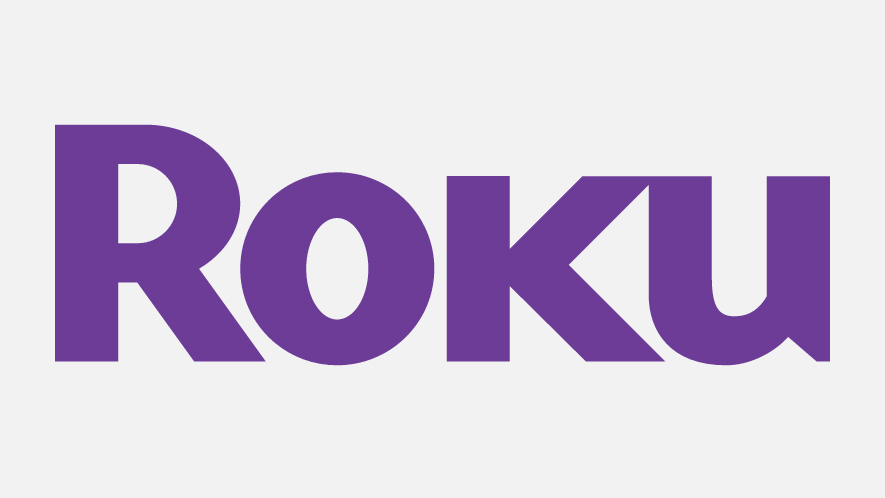
How To Download & Install App On Roku
How to incorporate an anecdote in your essay.
Before we begin, let’s first understand the meaning of an anecdote. Well, these are short stories about an experience that’s closely related to what you’re writing. It could be your own experience or a borrowed one, as long as it’s relevant to your essay.
An example of an anecdote used in real-life situations is interrupting your line of thought to give a story relevant to what you were talking about.
Let’s look at how to use anecdotes in your essay.
Table of Contents
Why Use Anecdotes?
Good question right? Like why would you interrupt your reader with a story when you can use simple words to explain what you’re saying? Well, story-telling is an excellent way of keeping the attention of a reader.
When you tell people something relevant to what you’re writing, they’re related more with your write up.
Giving your essay a personal perspective makes people think about their own experiences as they read. This also makes it easy for you to illustrate the points you’re trying to make.
The best thing about anecdotes is that they can be used in different essays. You can use them when writing non-fiction, as well as english essays help .
They liven up write-ups because the reader can focus on an exciting story for a short while before they go back to the subject matter.
How to Write an Anecdote
Now let’s get down to it!
To begin with, you should make sure that your anecdote is relevant to what you’re writing. Context is essential when you’re incorporating a short story.
For instance, if you’re writing about a dog, telling a story about your cat is going off-topic. Even though both of them are house pets, a can is wildly different from a dog.
Always ask yourself why you need to incorporate the anecdote in the first place. Don’t just do it for the sake of it.
Other questions you should also yourself include;
- Who was involved in the story?
- What happened in your story?
- When did it happen?
- Where did it happen?
- Is this relevant?
Even though an anecdote is a short story , you should structure it the same way you would, a long story. First, introduce it, say what happened, and then draw a conclusion that corresponds with the point you’re trying to make. Alternatively, you can also a question and let your readers let their own conclusion.
The most important aspect of an anecdote is the punchline. Whether your punchline is intended to be hilarious or serious, make sure the story builds up to it. Since you should save the best for last, your punchline should be the very last thing you detail.
As you begin your anecdote, make sure the first thing you mention if the characters involved in your story.
The Differences between Anecdotes and Stories
The main difference between anecdotes and normal stories is that anecdotes are short. Your anecdote should not be more than two paragraphs.
When you write stories, you get to include more details because you need to really draw the reader into your scenes. In anecdote however, the main aim is to further illustrate a point you’re making in an essay.
Your anecdote can actually be as short as one short as one sentence. Examples include;
- “My dog always want to play when I get home from work.”
- “Nicole is so aggressive, she always gets what she sets her mind to.”
- “When I was in college, I worked in the school’s cafeteria over the weekends.”
That said, you should know that these are not great anecdotes, but they’re anecdotes nonetheless.
Conclusion
Incorporating an anecdote is an excellent way of illustrating your points in a write-up. It’s also a go-to for anyone who wants to make their article longer. Make sure that the short story you’re incorporating is relevant to the topic you’re discussing.

How to write an anecdote? A Definitive Guide for Writers
What is an anecdote, understanding the purpose of an anecdote, knowing when to use an anecdote, the different types of anecdotes, examples of anecdotes from famous writers, the do’s and don’ts of writing anecdotes.
- How to write an effective anecdote
Anecdote writing tips for writers
Anecdote exercises for writers.
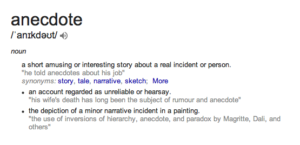
The do’s
The don’ts, how to write an effective anecdote.
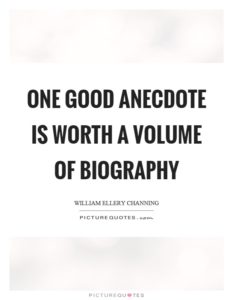
Daily Writing Tips
How to write an essay for a scholarship: a step-by-step guide.
Crafting an essay for a scholarship is your chance to show why you’re a worthy investment. It’s not just another essay; it’s a personal narrative that embodies your aspirations and showcases your potential.
In this step-by-step guide, we’ll lead you through each part of the scholarship essay process: understanding the prompt, outlining your thoughts, engaging introductions, strong body paragraphs, impactful conclusions, and essential revisions. Plus, we’ll touch on those final checks before you hit submit.
Ready to turn your educational dreams into a compelling story? Let’s begin the journey of writing an essay that might just change the course of your future.
What Is a Scholarship Essay and Why Is It Important?
A scholarship essay is a written piece you submit as part of your college or university scholarship application. It’s your opportunity to demonstrate to the scholarship committee why you are the best candidate for the award.
The scholarship essay is important because it allows the committee to get to know you beyond your grades and test scores. It lets you share your personal story, accomplishments, and future plans.
What Are Scholarship Essay Prompts Asking For?

Scholarship essay prompts typically ask you to discuss your academic achievements, extracurricular activities, community service, leadership roles, or any challenges you’ve overcome. The prompt will guide you in showcasing your unique qualifications. For example, a prompt might ask you to describe a time when you demonstrated leadership or to explain how a particular experience has shaped your academic and career goals.
How Can You Plan Your Scholarship Essay Effectively?
Effective planning is the key to writing a strong scholarship essay. Here are the steps to follow:
1. Read the prompt carefully: Start by thoroughly reviewing to understand the requirements and instructions of the essay prompt. Make sure you know exactly what the prompt is asking you to do.
2. Brainstorm experiences and accomplishments: Reflect on your academic, extracurricular, and personal experiences that might help explain the prompt. Think about your achievements, the challenges you’ve overcome, and how you’ve made a difference in your community.
3. Develop a thesis or central theme: Based on your brainstorming, determine a thesis or central theme that will help focus your essay. This statement should explain the main point you want the scholarship committee to understand.
4. Create an outline: Organize your essay by making an outline. Include an introduction, body paragraphs, and a conclusion. This will help you write a structured and coherent essay.
5. Do additional research: Depending on the prompt, you may need to research relevant information to support your essay. For example, if the prompt asks you to discuss a social issue, you may need to research facts and statistics to support your points.
6. Allow time for writing and revising: Don’t wait until the last minute to write your essay. Give yourself enough time to write a draft, get feedback, and make revisions . Rushing through the process can result in a weaker essay.
How Do You Create a Compelling Introduction for Your Scholarship Essay?
The introduction is the first thing the scholarship committee will read, so making a strong impression is important. Here are the steps to create a compelling introduction:
1. Hook the reader: Start your introduction with a captivating hook , such as a quote, anecdote, or intriguing statement. This will immediately engage the reader and make them want to continue reading.
2. Provide context: Offer relevant background information to give the reader context about who you are and your experiences. This could include details about your academic background, extracurricular activities, or personal interests.
3. State your central thesis : Clearly articulate your essay’s main point or argument, aligning it with the scholarship prompt. This thesis statement should be a concise and clear statement of the key idea you will explore in your essay.
4. Outline your approach: Give the reader a sense of how you will develop your essay’s central theme throughout the body paragraphs. This can be a brief overview of the main points you will cover.
5. Express your passion: Convey your enthusiasm, motivation, and personal investment in the topic and your pursuit of the scholarship. This will help the committee understand why this scholarship is important to you.
6. Keep it concise: Aim for 3-5 engaging sentences that introduce your essay in a manner that is easy to understand and compelling. The introduction should be long enough to capture the reader’s attention but not so long that it becomes overwhelming.
What Makes a Strong Body for Your Scholarship Essay?

The body of your scholarship essay is where you will expand on your central theme and provide evidence to support your points. Provide specific examples and evidence from your experiences to support your arguments. This could include details about your academic achievements, extracurricular involvement, community service, or personal challenges you’ve overcome.
Use the body paragraphs to showcase your unique qualities and how they make you a strong candidate for the scholarship. This could include your leadership skills, problem-solving abilities, creativity, or dedication to your studies. Keep your essay logically organized and focused on the main point you want to make, with each paragraph building on the previous one and contributing to the overall argument you’re making.
Vary your sentence structure to keep your writing engaging and easy to read. Alternate between shorter and longer sentences, and help guide the reader through your essay. Back up your claims and arguments with relevant facts, statistics, or expert opinions to strengthen the credibility of your essay.
How Should You Conclude Your Scholarship Essay?
The conclusion of your scholarship essay is your final opportunity to make an impression on the committee. In the conclusion, restate your thesis or central theme in a clear and understandable way. This will remind the reader of the main point you’ve been focused on throughout your essay.
Briefly summarize the key points and arguments you made in the body of your essay. This will help reinforce your main ideas and leave a lasting impression on the reader. Explain why the scholarship is important to you and how it will help you achieve your academic and career goals. Demonstrate your passion and commitment to making the most of the scholarship opportunity.

Conclude your essay with a strong, memorable statement that leaves the reader with a positive impression of you as a candidate. This could be a call to action, an inspirational quote, or a final reflection on the significance of the scholarship.
How Can You Revise Your Scholarship Essay for Maximum Impact?
After you’ve written your first draft, it’s important to revise and edit your essay so it’s as strong as it can be. Carefully read through your essay to catch any spelling, grammar, or punctuation errors. Even small mistakes can ruin the overall quality of your essay.
Ask someone you trust, such as a teacher, mentor, or family member, to review your essay and provide feedback. They may be able to locate areas for improvement or offer a fresh perspective. Ask them to review your essay’s organization to ensure your introduction, body, and conclusion flow logically. Don’t be afraid to rearrange or add/remove paragraphs to strengthen the overall structure.
Examine your essay’s central arguments and claims. Are they supported with sufficient evidence and examples? Look for ways to develop your points further. Review your writing style and make adjustments to improve clarity, concision, and engagement. This could involve varying sentence structure, eliminating unnecessary words, or using more vivid and descriptive language.
Double-check that your essay fully addresses the scholarship prompt and showcases your qualifications in a way that aligns with the committee’s expectations. Don’t be afraid to make multiple rounds of revisions. The more you refine your essay, the stronger it will be.
What Are the Final Steps Before Submitting Your Scholarship Essay?
Once you’ve completed your revisions, there are a few final steps to take before submitting your scholarship essay. Take advantage of sources that provide essay and paper help to add to and ensure the quality you have written is up to the scholarship committee’s standards. Also, always be sure to review everything
1. Follow instructions: Carefully review the scholarship guidelines and instructions to ensure you’ve followed all the requirements, including formatting, length, and submission procedures.
2. Double-check formatting: Ensure your essay is properly formatted according to the scholarship guidelines, including margins, font size, and spacing.
3. Proofread again : Do one final proofread to catch any lingering errors or typos. It’s easy to miss mistakes when you’ve been working on the essay for a long time.
4. Submit before the deadline: Don’t wait until the last minute to submit your essay. Allow plenty of time to complete the application process and submit your materials before the deadline. 5. Make copies: Keep a copy of your final essay for your records. This can be helpful if you need to refer back to it or make adjustments for future scholarship applications.
Here are some dos and don’ts for effective scholarship essay writing
- Understand the Prompt: Carefully read and analyze the scholarship prompt to ensure your essay directly addresses the requested topic or criteria.
- Showcase Your Unique Qualities: Use the essay as an opportunity to highlight your distinctive experiences, skills, goals, and passions that make you a standout candidate.
- Organize Your Essay Logically: Craft a clear and well-structured essay with an engaging introduction, cohesive body paragraphs, and a compelling conclusion.
- Support Your Claims: Back up your key points and arguments with specific examples, anecdotes, and evidence from your experiences.
- Maintain a Positive and Enthusiastic Tone**: Convey your enthusiasm for the scholarship and your commitment to making the most of the opportunity.
- Proofread and Edit Carefully: Review your essay multiple times to catch any grammar, spelling, or punctuation errors.
- Follow All Formatting Requirements: Adhere to the prescribed page limits, font sizes, and other formatting guidelines specified by the scholarship provider.

Don’ts
- Don’t Repeat the Prompt: Avoid simply restating the prompt in your essay. Instead, use your unique voice and perspective.
- Don’t Make Broad, Unsupported Statements: Avoid making claims or generalizations without providing concrete evidence or examples to support them.
- Don’t Use Clichés or Overly Formal Language: Steer clear of overused phrases and maintain a natural, conversational tone throughout your essay.
- Don’t Exaggerate or Embellish: Be honest and authentic in your writing . Avoid making claims that you cannot substantiate.
- Don’t Neglect the Conclusion: Don’t treat the conclusion as an afterthought. Use it to leave a lasting, positive impression on the reader.
- Don’t Miss Deadlines or Requirements: Ensure you submit your essay by the specified deadline and adhere to all other requirements outlined by the scholarship provider.
- Don’t Plagiarize: Ensure that your essay is entirely your own work and that you properly cite any external sources you use.
Following these dos and don’ts can help you craft a compelling scholarship essay that stands out from the competition.
Writing a good scholarship essay is important to get the funding you need for your education and career goals. By following the steps in this guide – understanding the prompt, brainstorming your experiences, writing a strong introduction and body, and leaving a lasting conclusion – you can create an essay that makes you stand out as an excellent candidate.
The essay is not just about listing your accomplishments – it’s about showing who you are as a person and why you are the ideal recipient. Infuse it with enthusiasm, personal stories, and a vision for your future. This will help you craft an essay that leaves a lasting impression.
As you prepare to submit your scholarship essay, be proud of your work and confident that you’ve presented your best self.
Stop making those embarrassing mistakes! Subscribe to Daily Writing Tips today!
You will improve your English in only 5 minutes per day, guaranteed!
Each newsletter contains a writing tip, word of the day, and exercise!
You'll also get three bonus ebooks completely free!

Leave a Comment

How to Start an Essay with Strong Hooks and Leads
ALWAYS START AN ESSAY WITH AN ENGAGING INTRODUCTION
Getting started is often the most challenging part of writing an essay, and it’s one of the main reasons our students are prone to leaving their writing tasks to the last minute.
But what if we could give our students some tried and tested tips and strategies to show them how to start an essay?
What if we could give them various strategies they could pull out of their writer’s toolbox and kickstart their essays at any time?
In this article, we’ll look at tried and tested methods and how to start essay examples to get your students’ writing rolling with momentum to take them to their essays’ conclusion.
Once you have worked past the start of your essay, please explore our complete guide to polishing an essay before submitting it and our top 5 tips for essay writing.

WHAT IS THE PURPOSE OF AN ESSAY’S INTRODUCTION?
Essentially, the purpose of the introduction is to achieve two things:
1. To orientate the reader
2. To motivate the reader to keep reading.
An effective introduction will give the reader a clear idea of what the essay will be about. To do this, it may need to provide some necessary background information or exposition.
Once this is achieved, the writer will then make a thesis statement that informs the reader of the main ‘thrust’ of the essay’s position, the supporting arguments of which will be explored throughout the body paragraphs of the remainder of the essay.
When considering how to start an essay, ensure you have a strong thesis statement and support it through well-crafted arguments in the body paragraphs . These are complex skills in their own right and beyond the scope of this guide, but you can find more detail on these aspects of essay writing in other articles on this site that go beyond how to start an essay.
For now, our primary focus is on how to grab the reader’s attention right from the get-go.
After all, the journey of a thousand miles begins with a single step or, in this case, a single opening sentence.
A COMPLETE UNIT ON WRITING HOOKS, LEADS & INTRODUCTIONS

Teach your students to write STRONG LEADS, ENGAGING HOOKS and MAGNETIC INTRODUCTIONS for ALL TEXT TYPES with this engaging PARAGRAPH WRITING UNIT designed to take students from zero to hero over FIVE STRATEGIC LESSONS.
WHAT IS A “HOOK” IN ESSAY WRITING?
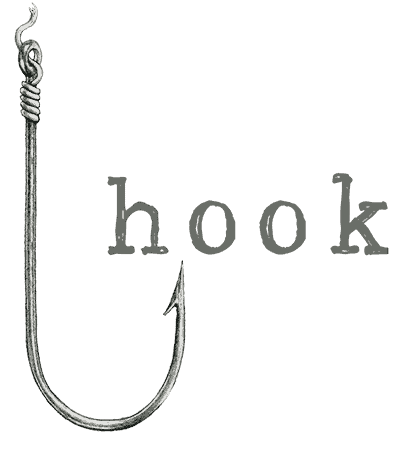
A hook is a sentence or phrase that begins your essay, grabbing the reader’s attention and making them want to keep reading. It is the first thing the reader will see, and it should be interesting and engaging enough to make them want to read more.
As you will learn from the how to start an essay examples below, a hook can be a quote, a question, a surprising fact, a personal story, or a bold statement. It should be relevant to the topic of your essay and should be able to create a sense of curiosity or intrigue in the reader. The goal of a hook is to make the reader want to read on and to draw them into the central argument or point of your essay.
Some famous examples of hooks in literature you may have encountered are as follows.
“It was the best of times, it was the worst of times” Charles Dickens in A Tale of Two Cities
“It was a bright cold day in April, and the clocks were striking thirteen” George Orwell in 1984
“It is a truth universally acknowledged, that a single man in possession of a good fortune, must be in want of a wife” – Jane Austen in Pride and Prejudice Jane Austen in Pride and Prejudice
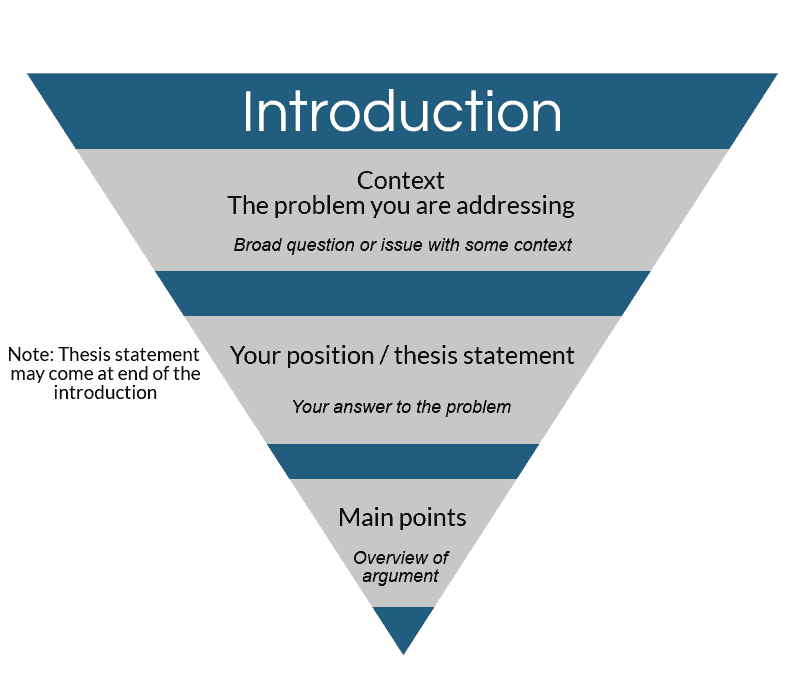
HOW TO HOOK THE READER WITH ATTENTION-GRABBING OPENING SENTENCES
We all know that every essay has a beginning, a middle , and an end . But, if our students don’t learn to grab the reader’s attention from the opening sentence, they’ll struggle to keep their readers engaged long enough to make it through the middle to the final full stop. Take a look at these five attention-grabbing sentence examples.
- “The secret to success is hidden in a single, elusive word: persistence.”
- “Imagine a world without electricity, where the only source of light is the flame of a candle.”
- “It was the best of times, it was the worst of times, but most importantly, it was the time that changed everything.”
- “They said it couldn’t be done, but she proved them wrong with her grit and determination.”
- “He stood at the edge of the cliff, staring down at the tumultuous ocean below, knowing that one misstep could mean certain death.”
Regardless of what happens next, those sentences would make any reader stop whatever else they might focus on and read with more intent than before. They have provided the audience with a “hook” intended to lure us further into their work.
To become effective essay writers, your students need to build the skill of writing attention-grabbing opening sentences. The best way of achieving this is to use ‘hooks’.
There are several kinds of hooks that students can choose from. In this article, we’ll take a look at some of the most effective of these:
1. The Attention-Grabbing Anecdote
2. The Bold Pronouncement!
3. The Engaging Fact
4. Using an Interesting Quote
5. Posing a Rhetorical Question
6. Presenting a Contrast
How appropriate each of these hooks is will depend on the essay’s nature. Students must consider the topic, purpose, tone, and audience of the essay they’re writing before deciding how best to open it.
Let’s look at each of these essay hooks, along with a practice activity students can undertake to put their knowledge of each hook into action.
1: HOW TO START AN ESSAY WITH “THE ATTENTION-GRABBING ANECDOTE”
Anecdotes are an effective way for the student to engage the reader’s attention right from the start.
When the anecdote is based on the writer’s personal life, they are a great way to create intimacy between the writer and the reader from the outset.
Anecdotes are an especially useful starting point when the essay explores more abstract themes as they climb down the ladder of abstraction and fit the broader theme of the essay to the shape of the writer’s life.
Anecdotes work because they are personal, and because they’re personal, they infuse the underlying theme of the essay with emotion.
This expression of emotion helps the writer form a bond with the reader. And it is this bond that helps encourage the reader to continue reading.
Readers find this an engaging approach, mainly when the topic is complex and challenging.
Anecdotes provide an ‘in’ to the writing’s broader theme and encourage the reader to read on.
Examples of Attention-grabbing anecdotes
- “It was my first day of high school, and I was a bundle of nerves. I had always been a shy kid, and the thought of walking into a new school, surrounded by strangers was overwhelming. But as I walked through the front doors, something unexpected happened. A senior, who I had never met before, came up to me and said ‘Welcome to high school; it’s going to be an amazing four years.’ That one small act of kindness from a complete stranger made all the difference, and from that day on, I knew that I would be okay.”
- “I was in my math class and having a tough day. I had a test coming up, and I was struggling to understand the material. My teacher, who I had always thought was strict and unapproachable, noticed that I was struggling and asked if I needed help. I was surprised, but I took her up on her offer, and she spent extra time with me after class, helping me to understand the material. That experience taught me that sometimes, the people we think we know the least about are the ones who can help us the most.”
- “It was the last day of 8th grade, and we were all sitting in the auditorium, waiting for the ceremony to begin. Suddenly, the principal got on stage and announced that there was a surprise guest speaker. I was confused and curious, but when the guest walked out on stage, I couldn’t believe my eyes. It was my favorite rapper who had come to speak to us about the importance of education. That moment was a turning point for me, it showed me that if you work hard and believe in yourself, anything is possible.”
Attention-Grabbing Anecdote Teaching Strategies
One way to help students access their personal stories is through sentence starters, writing prompts, or well-known stories and their themes.
First, instruct students to choose a theme to write about. For example, if we look at the theme of The Boy Who Cried Wolf, something like: we shouldn’t tell lies, or people may not believe us when we tell the truth.
Fairytales and fables are great places for students to find simple themes or moral lessons to explore for this activity.
Once they’ve chosen a theme, encourage the students to recall a time when this theme was at play in their own lives. In the case above, a time when they paid the cost, whether seriously or humorously, for not telling the truth.
This memory will form the basis for a personal anecdote that will form a ‘hook’. Students can practice replicating this process for various essay topics.
It’s essential when writing anecdotes that students attempt to capture their personal voice.
One way to help them achieve this is to instruct them to write as if they were orally telling their story to a friend.
This ‘vocal’ style of writing helps to create intimacy between writer and reader, which is the hallmark of this type of opening.
2: HOW TO START AN ESSAY WITH “THE BOLD PRONOUNCEMENT”
As the old cliché “Go big or go home!” would have it, making a bold pronouncement at the start of an essay is one surefire way to catch the reader’s attention.
Bold statements exude confidence and assure the reader that this writer has something to say that’s worth hearing. A bold statement placed right at the beginning suggests the writer isn’t going to hedge their bets or perch passively on a fence throughout their essay.
The bold pronouncement technique isn’t only useful for writing a compelling opening sentence, the formula can be used to generate a dramatic title for the essay.
For example, the recent New York Times bestseller ‘Everybody Lies’ by Seth Stephens-Davidowitz is an excellent example of the bold pronouncement in action.
Examples of Bold Pronouncements
- “I will not be just a statistic, I will be the exception. I will not let my age or my background define my future, I will define it myself.”
- “I will not be afraid to speak up and make my voice heard. I will not let anyone silence me or make me feel small. I will stand up for what I believe in and I will make a difference.”
- “I will not be satisfied with just getting by. I will strive for greatness and I will not be content with mediocrity. I will push myself to be the best version of me, and I will not settle for anything less.”
Strategies for Teaching how to write a Bold Pronouncement
Give the students a list of familiar tales; again, Aesop’s Fables make for a good resource.
In groups, have them identify some tales’ underlying themes or morals. For this activity, these can take the place of an essay’s thesis statement.
Then, ask the students to discuss in their groups and collaborate to write a bold pronouncement based on the story. Their pronouncement should be short, pithy, and, most importantly, as bold as bold can be.
3: HOW TO START AN ESSAY WITH “THE ENGAGING FACT”
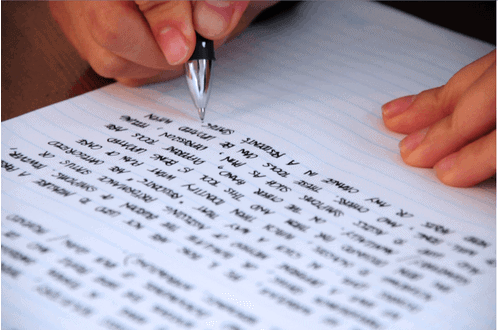
In our cynical age of ‘ fake news ’, opening an essay with a fact or statistic is a great way for students to give authority to their writing from the very beginning.
Students should choose the statistic or fact carefully, it should be related to their general thesis, and it needs to be noteworthy enough to spark the reader’s curiosity.
This is best accomplished by selecting an unusual or surprising fact or statistic to begin the essay with.
Examples of the Engaging Fact
- “Did you know that the average teenager spends around 9 hours a day consuming media? That’s more than the time they spend sleeping or in school!”
- “The brain continues to develop until the age of 25, which means that as a teenager, my brain is still going through major changes and growth. This means I have a lot of potential to learn and grow.”
- “The average attention span of a teenager is shorter than that of an adult, meaning that it’s harder for me to focus on one task for an extended time. This is why it is important for me to balance different activities and take regular breaks to keep my mind fresh.”
Strategies for teaching how to write engaging facts
This technique can work well as an extension of the bold pronouncement activity above.
When students have identified each of the fables’ underlying themes, have them do some internet research to identify related facts and statistics.
Students highlight the most interesting of these and consider how they would use them as a hook in writing an essay on the topic.
4: HOW TO START AN ESSAY USING “AN INTERESTING QUOTATION”
This strategy is as straightforward as it sounds. The student begins their essay by quoting an authority or a well-known figure on the essay’s topic or related topic.
This quote provides a springboard into the essay’s subject while ensuring the reader is engaged.
The quotation selected doesn’t have to align with the student’s thesis statement.
In fact, opening with a quotation the student disagrees with can be a great way to generate a debate that grasps the reader’s attention from the outset.
Examples of starting an essay with an interesting quotation.
- “As Albert Einstein once said, ‘Everybody is a genius. But if you judge a fish by its ability to climb a tree, it will live its whole life believing that it is stupid.’ As a 16-year-old student, I know how it feels to be judged by my ability to climb the “academic tree” and how it feels to be labeled as “stupid”. But just like the fish in Einstein’s quote, I know that my true potential lies in my unique abilities and talents, not in how well I can climb a tree.”
- “Mark Twain once said, ‘Whenever you find yourself on the side of the majority, it is time to pause and reflect.’ This quote resonates with me because as a teenager, I often feel pressure to conform to the expectations and opinions of my peers. But this quote reminds me to take a step back and think for myself, rather than blindly following the crowd.”
- “As J.K. Rowling famously said, ‘It does not do to dwell on dreams and forget to live.’ As a 16-year-old student, I often find myself getting lost in my dreams for the future and forgetting to live in the present. But this quote serves as a reminder to me to strive for my goals while also cherishing and living in the here and now.”
Teaching Strategies for starting an essay with an interesting quotation.
To gain practice in this strategy, organize the students into groups and have them generate a list of possible thesis statements for their essays.
Once they have a list of statements, they now need to generate a list of possible quotations related to their hypothetical essay’s central argument .
Several websites are dedicated to curating pertinent quotations from figures of note on an apparently inexhaustible array of topics. These sites are invaluable resources for tracking down interesting quotations for any essay.
5: HOW TO START AN ESSAY BY “POSING A RHETORICAL QUESTION”
What better way to get a reader thinking than to open with a question?
See what I did there?
Beginning an essay with a question not only indicates to the reader the direction the essay is headed in but also challenges them to respond personally to the topic.
Rhetorical questions are asked to make a point and to get the reader thinking rather than to elicit an answer.
One effective way to use a rhetorical question in an introduction is to craft a rhetorical question from the thesis statement and use it as the opening sentence.
The student can then end the opening paragraph with the thesis statement itself.
In this way, the student has presented their thesis statement as the answer to the rhetorical question asked at the outset.
Rhetorical questions also make for valuable transitions between paragraphs.
Examples of starting an essay with a rhetorical question
- “What if instead of judging someone based on their appearance, we judged them based on their character? As a 16-year-old, I see the damage caused by judging someone based on their physical appearance, and it’s time to move away from that and focus on character.”
- “How can we expect to solve the world’s problems if we don’t start with ourselves? As a 16-year-old student, I am starting to see the issues in the world, and I believe that before we can make any progress, we need to start with ourselves.”
- “What would happen if we stopped labelling people by race, religion, or sexual orientation? As a teenager growing up in a diverse world, I see the harm caused by labelling and stereotyping people; it’s time for us to stop and see people for who they truly are.”
Teaching Students how to start an essay with a rhetorical question
To get some experience posing rhetorical questions, organize your students into small groups, and give each group a list of essay thesis statements suited to their age and abilities.
Task the students to rephrase each of the statements as questions.
For example, if we start with the thesis statement “Health is more important than wealth”, we might reverse engineer a rhetorical question such as “What use is a million dollars to a dying man?”
Mastering how to start an essay with a question is a technique that will become more common as you progress in confidence as a writer.
6: HOW TO START AN ESSAY BY “PRESENTING A CONTRAST”
In this opening, the writer presents a contrast between the image of the subject and its reality. Often, this strategy is an effective opener when widespread misconceptions on the subject are widespread.
For example, if the thesis statement is something like “Wealth doesn’t bring happiness”, the writer might open with a scene describing a lonely, unhappy person surrounded by wealth and opulence.
This scene contrasts a luxurious setting with an impoverished emotional state, insinuating the thrust of the essay’s central thesis.
Examples of Starting an essay by presenting a contrast
- “On one hand, technology has made it easier to stay connected with friends and family than ever before. On the other hand, it has also created a sense of disconnection and loneliness in many people, including myself as a 16-year-old. “
- “While social media has allowed us to express ourselves freely, it has also led to a culture of cyberbullying and online harassment. As a teenager, I have seen social media’s positive and negative effects.”
- “On one hand, the internet has given us access to a wealth of information. On the other hand, it has also made it harder to separate fact from fiction and to distinguish credible sources from fake news. This is becoming increasingly important for me as a 16-year-old student in today’s society.”
Teaching Strategies for presenting a contrast when starting an essay.
For this activity, you can use the same list of thesis statements as in the activity above. In their groups, challenge students to set up a contrasting scene to evoke the essay’s central contention, as in the example above.
The scene of contrast can be a factual one in a documentary or anecdotal style, or a fictionalized account.
Whether the students are using a factual or fictional scene for their contrast, dramatizing it can make it much more persuasive and impactful.
THE END OF THE BEGINNING
These aren’t the only options available for opening essays, but they represent some of the best options available to students struggling to get started with the concept of how to create an essay.
With practice, students will soon be able to select the best strategies for their needs in various contexts.
To reinforce their understanding of different strategies for starting an introduction for an essay, encourage them to pay attention to the different choices writers make each time they begin reading a new nonfiction text.
Just like getting good at essay writing itself, getting good at writing openings requires trial and error and lots and lots of practice.
USEFUL VIDEO TUTORIALS ON WRITING AN ESSAY INTRODUCTION


How to Turn a Real-Life Moment into an Anecdote
by j9robinson | Aug 19, 2014

I confess: I love anecdotes.
These are basically when a writer shares a mini-story about a real-life moment or experience.
Usually, they are plucked out of the past, and presented without much introduction.
Their power is that they draw you into a story, or college application essay, by starting with a punch of drama.
Anecdotes make awesome introductions.
The key is to get as close to the action as possible.
I’ve written tips and advice on how to write anecdotes , but thought I would try to model an example.
They seem so simple when you read them, but they are harder than you might think to craft.
The trick is to practice, and study how other anecdotes are put together.
The most common place to find them is at the start of longer newspaper pieces or magazine stories, or of course, personal (narrative) essays .
I advise students to search their past for “times” or incidents or experiences that happened to them, which they can use to start their essays to illuminate something (quality, characteristic, talent, etc…) about themselves.
I thought about my defining qualities way back in high school, and one was that I wanted to be adventuresome.
So here is a “time” when I was trying to be adventuresome.
Like all good stories (including mini-stories like anecdotes), the best ones involve some type of problem.
My problem in this case was that we were about to get in trouble.

Here’s what happened if I just tell it to you straight, as in describe it to you.
Then you can compare how I re-wrote it in a more story-telling or fiction-like style to craft it into an anecdote.
I’m hoping this will help you learn to convert your real-life moments or experiences into anecdotes:
I had just spent the summer after graduating high school waiting tables at a lodge in a national park in Wyoming, and decided to hitchhike home with a friend to St. Louis, Missouri.
(This was in the late 70s, when people still hitchhiked–although it was pretty stupid even then.
So I do not advise this mode of travel.) Anyway, a guy who gave us a ride in Montana (we were up in Glacier Park) told us a hot tip: We should hop a freight train east.
It would be a lot easier and more direct, he said.
RELATED: My Video Tutorial on How to Write an Anecdote: Part One
At the time, all I thought about was how cool that sounded—and totally ignored how dangerous it could be.
He told us to meet a friend of his who tended a corner bar in a tiny town, called Havre, and that guy would help us figure out the trains. The bartender told us to go to the train yard early in the morning (like 4 a.m.) and pick one of the longer trains heading east, and to get in a car closer to the engine (less bumpy.)
So we did, and it was totally scary in the pitch dark around all these parked giant trains, and eventually climbed into an open freight car and tried to hide in the corner (There was no “hopping” involved.).
At one point, a train worker found us, but for some reason didn’t kick us out.
We road that train all the way to Fargo, North Dakota.
Ok, now I will extract an anecdote out of that “time,” and try to start as close to the “drama” or highlight of the action or tension or conflict or problem as possible.
(This “moment” is from the sentence in bold above.)
This is one way to write it:
Crouched in the far corner of the darkened freight car with my friend, I buried my head in my knees and waited. It had been almost an hour and the train had yet to budge. Then I heard the footsteps, which sounded like boots on gravel, that grew louder and louder. They stopped abruptly, apparently right outside the open door. I squeezed my eyes shut, but still could tell when something, a flashlight or lantern, was illuminating our car. I held my breath. To my relief, the footsteps started again.
“Evening folks,” said a deep, soft voice, before the footsteps faded into the distance.
(Back Story) That terrifying night last summer, when I hopped my first freight train on my way home after a summer waiting tables in the Rocky Mountains, was one of the most frightening times of my life, but at the same time, part of an adventure that taught me how much I was willing to risk for a free ride….We had started out hitching hiking, but then…
If you are trying to put together an anecdote about one of your experiences or a meaningful moment from your past, start by writing it out straight like I did, just recounting what happened.
Then you can extract the details that you need to tell it like a story.
Identify the moment closest to the action or excitement. Find the best details that describe the setting.
Where were you when it happened? Who were you with? What happened?
What did you hear, smell, touch, etc…
How did you feel?
Include a piece of dialogue–from someone else or even quote your own thoughts–to give it that narrative feeling.
One tip is to make sure to put yourself right in the middle of the action.
Notice how I started by describing myself “Crouched in a the far corner…”
Begin by saying where you were, or what you were doing, then go from there.
This is often a great way to get started. You want the anecdote to be from your point of view, right at the center of the action.
At first, your anecdote might run long.
If so, just go back and trim out anything that you don’t need, but leave the details to help it make sense.
You will flush out the “back story” or larger context later in the piece.
Like I said, these take practice.
But they are very powerful writing techniques.
There’s no better way to put the reader in your shoes, and feel your pain, or thoughts or emotions.
It’s the perfect way to help them care about you and what you have to say right off the bat.
And this is what you want with your college application essay!
My Video Tutorial on How to Write an Anecdote: Part One
Check Out These Related Posts!

Loving your page, thank you!
Trackbacks/Pingbacks
- A-Z of Travel Writing Tips: A is for Audience, Action and ... - Birds of a Feather - […] How to Turn a Real-Life Moment into an Anecdote […]
Submit a Comment Cancel reply
Your email address will not be published. Required fields are marked *
Click logo to visit Home Page!

Need More Help?

As a professional writing coach, I help students, parents, counselors, teachers and others from around the world on these dreaded essays! Learn about my in-person and online tutoring, editing, workshops, books, and online courses, ... READ MORE... .
Online Course
Learn to write your essay in one hour.

My on-demand, fast-and-easy online e-course: How to Write a College App Essay (Click lightbulb for details.)
Perfect for The Common App, UCs, grad school, transfer and scholarship essays!
Buy Course for $99 and Start Now!
Find helpful posts.
- About Admissions Officers
- Add a Twist
- Admissions Advice
- Affordability and Success
- Anecdote How-To
- ApplyTexas Essays
- Avoid "English-ese"
- Beware English teachers
- Brainstorm Guide
- Bump Up a Dull Essay
- Cappex Application essays
- Another Trick to Try
- Defining Qualities
- Focusing Your Topic
- Good Topics vs Bad Topics
- How to Stand Out
- Jumpstart Guide!
- Mundane Topics
- Risky Topics
- Show Your Grit
- The "Unexpected"
- Top Five Topic Tips
- Topic of Choice
- Topics to Avoid!
- Twilight as a Topic?
- Coalition for Access
- Coalition for Access Essay Strategies
- College Rejection
- Common App Prompt 7
- Common App: Prompt 1
- Common App: Prompt 2
- Common App: Prompt 3
- Common App: Prompt 4
- Common App: Prompt 5
- Common App: Prompt 6
- Commonly Asked Questions
- Conclusions
- Create Pathos
- Creative Writing
- English Teachers Help
- Essay Cheat Sheet
- Essay Contest
- Essay Hell's Writing Guides
- Essay Myths
- Essay Writing Guides
- Essay Writing Training
- Find Core Values
- First drafts
- Grabber Introductions
- Heavenly Essays Book
- Homeschooling
- How Format Common App Essay
- How to Describe a Place/Setting/World
- How to Recycle Essays
- How to Write a Conclusion
- How to Write Short Essays
- International Students
- Journal Writing
- Jumpstart Essay Experts
- Lesson Plans
- Math and Science Students
- How to manage your parents
- Personal Insight Questions
- Personal Statements
- Favorite Books
- Sample Essays
- Scholarship Essays
- Storytelling
- Supplemental Essay Tips
- Tufts Supplemental Essays
- University of Colorado Supp
- Why College X?
- Texas Essay Prompts
- How to Answer Prompt #1
- Golden Advice from a College Insider
- Title Your Essay
- TMI in Essays
- Top Essay Fears
- Transfer Essays
- Transfer Students
- UC Prompt #1
- UC Prompt #2
- UC Transfer Essays
- Uncategorized
- Underprivileged Students
- UC Prompt 4
- UC Prompt 5
- UC Prompt 8
- University of Texas essays
- Video Tutorials
- Waitlist Essays and Letter
- Warning to Top Students
- What Makes a Great Essay?
- When You Are Done
- Where to Start
- Why Essays Matter
- Be Specific
- Black and white thinking
- Don't Impress
- Final checklist
- Grabber introductions
- How Find Your Main Point\
- How to Add Depth
- How to add intellectual vitality
- How to Tell a Story
- How to Write an Anecdote
- Ladder of Abstraction
- Mini-Memoirs
- Online course for writing college admissions essays
- Self-editing
- Show AND Tell
- Show Don't Tell
- Tone and Voice
- Universal Truths
- Use Emotion
- Writing Contests
Bestselling Writing Guide!
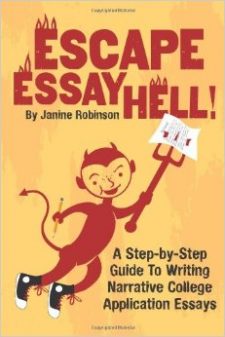
Click book image to learn about all four of my popular writing guides!
Get the Reddit app
Discussions about the writing craft.
When is it ok to start an essay with an anecdote?
I want to do it and I have seen many authors do it, however since I'm not a recognized writer I feel doing that would be pretentious. What do you think?

- Graduate Programs
- Request Information

5 Ways to Perfect Your Graduate School Application Essay
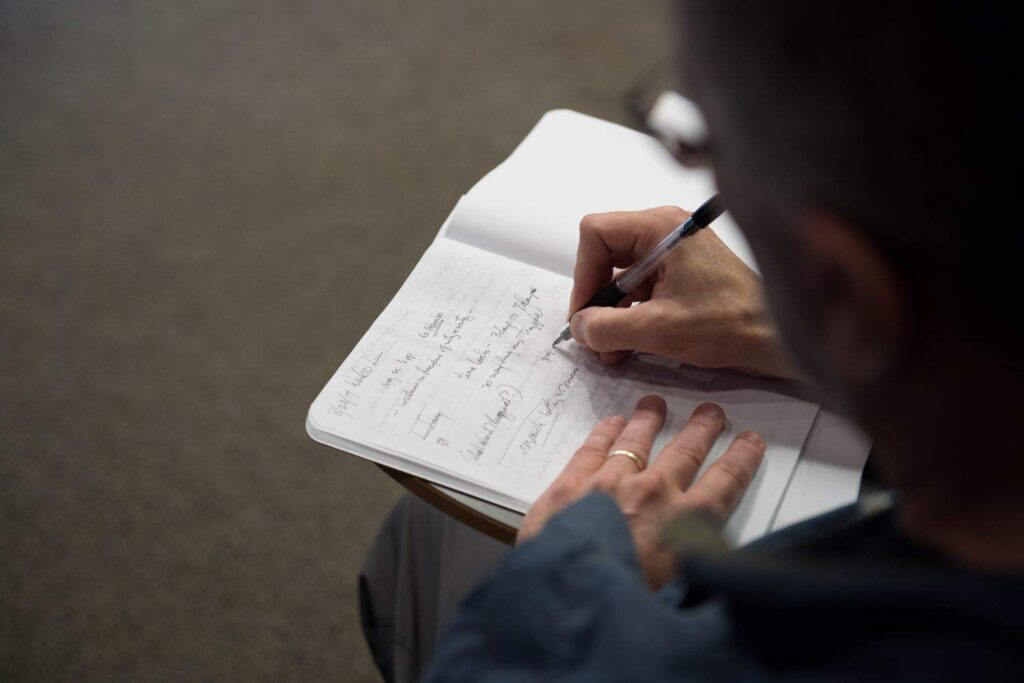
If you’re considering graduate school , you have probably come across application essay requirements. To many, the thought of distilling your experiences and personality into one brief essay can be daunting. How do you show these graduate admissions teams all of the great reasons why you would be perfect for their program within a couple of pages? Today’s blog will help you navigate the application essay process. We’ll provide tips on how to write a strong application essay that will stand out to graduate admissions teams.
Tip 1: Give yourself plenty of time
Everyone’s process is different, but in my experience, the best writing comes from taking your time. For me, I need a day or two to step away from my writing before I can edit it with fresh eyes. If I can take my time during the editing process, I’m able to catch the fine details, like a sentence that reads awkwardly or a tiny typo. Polishing your work is important, especially for graduate school applications. Schools are looking for applicants who can write and analyze at a graduate level, and your application essay is a glimpse into those skills. If your application essay doesn’t flow well or has grammatical issues, it can shed a poor light on those skills.
To ensure you have plenty of time to make your essay shine, start writing 3-4 weeks before the deadline. This way, you have time to write a draft, step away, edit it with fresh eyes, and even ask a friend to look over your draft. The fine-tuning process may just help your essay stand out among the dozens of other applicants who may have rushed their essays.
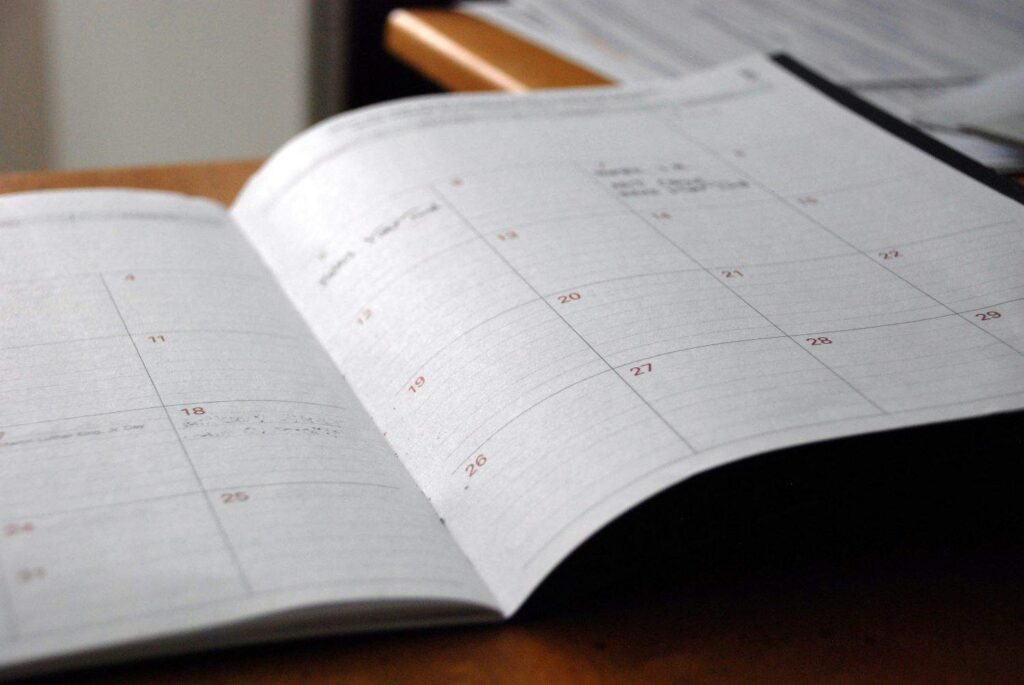
Tip 2: Make a plan
Now that you’ve set aside plenty of time for writing and editing, it’s time to plan what you want to say. Your plan could look like a formal outline , or it could just be a brainstorming session. Whatever works for you, take some time to sit with the application prompt and plan how you will answer.
It’s important to plan what examples you want to provide in your essay. You will probably write about your personal or professional qualities that make you a good fit for the program. Provide examples that demonstrate those qualities to your reader. As you read the essay prompt, think about specific anecdotes from your life that you can use to answer the question.
For example, let’s say a publishing program asks you why you want to study publishing. In your response, you might talk about how you read an article about disparities in the publishing industry and how that made you want to become an editor who promotes authors from historically marginalized groups. If you have an example of how you promoted equity in a past job, add that to your response to show you have already started taking action.
Whatever traits you highlight in your response, try to include real-life examples that illustrate these qualities. Once you have a plan of what you want to say in your response and what anecdotes you’ll use to support your points, it’ll be easier and quicker to get a draft written.
Tip 3: Fill in the gaps
When I started writing graduate application essays, I often fell into the trap of just rewriting my resume in a paragraph format. I was so anxious to demonstrate my experiences that I ended up just creating a list rather than a story. Don’t fall into the same trap!
Instead, think of your application essay as a way to fill in the gaps in your story. Your resume shows admissions teams what you have done, but your application essay should show them what you have learned from those experiences. How did you grow from that volunteer experience? What about your last job made you decide to return to school and change careers? These are the kinds of questions your application essay will answer for the admissions readers.
Additionally, your application essay is the place to showcase your personality . You want to keep your writing professional, but it’s okay to weave a bit of humor or quirkiness into your essay. Graduate programs want students who will add to the learning community, and showcasing your personality helps them envision how you’ll contribute to other students’ experiences.

Tip 4: Avoid generic stories and phrases
Because essay prompts are often general, it’s easy to write generic responses. If the prompt feels cliche, you might be tempted to use cliches in your response as well. Try to avoid this, since cliche phrases can make your writing seem less authentic to you. You’re trying to showcase your unique qualities, so using an over-used saying won’t help your cause. Some example cliches to avoid are “against all odds,” “little did I know,” “I learned more from them than they did from me,” etc.
The same goes for the anecdotes you use. The stories you tell in your essay should be unique to you and relate directly back to the prompt. Try to avoid tangential or cookie-cutter stories that don’t relate to your overall essay theme. For example, instead of talking about your babysitting business in high school to show that you are industrious, tell the admissions team about a recent work or school project you helped make possible.
Tip 5: Be aware of your audience
This final tip relates back to the editing process we discussed earlier. Regardless of the field, graduate programs need students who can read, analyze, and write at an advanced level. As such, be sure the writing mechanics in your essay are really tight. Make sure you don’t have run-on sentences, typos, or spelling issues. Try reading your essay aloud to find any problems with the flow of your writing. If you take the time to polish your writing, it will show, and you will be a more appealing candidate. Ultimately, there is no key to writing the perfect application essay. Hopefully, with these tips, you will feel more prepared to write a great essay. If you have more questions about the application process for Emerson graduate programs, be sure to schedule a call with us! We look forward to your unique stories and application essays.
- About Author
- Latest Posts
Olivia Wachtel
Writing Assistant
Olivia is a second-year student in Emerson's Communication Disorders MS program. Originally from Ohio, she is loving Emerson and city life. When she's not writing for the Grad Life blog, she loves to read, bake, and crochet.
Latest posts from Olivia Wachtel
- 5 Ways to Perfect Your Graduate School Application Essay - July 2, 2024
- Best 5 Business Careers for Creatives - June 25, 2024
- 5 Tips on How to Ask Your Boss for a Raise - June 18, 2024
Leave a Reply Cancel reply
Your email address will not be published. Required fields are marked *
Save my name, email, and website in this browser for the next time I comment.
BREAKING NEWS: DC Water puts boil water advisory in effect for all of DC, Arlington areas

5 Ways to Make Your Scholarship Essay Stand Out
U.S. News & World Report
July 1, 2024, 8:00 PM
- Share This:
- share on facebook
- share on threads
- share on linkedin
- share on email
It’s no secret college is expensive . One way to alleviate the cost burden is through scholarships , a form of financial aid that doesn’t need to be repaid. Scholarships can range from a few hundred dollars to several thousand dollars, but winning them requires strong credentials and a well-crafted essay.
With so many components to the college application , experts say it’s common for students to rush through certain parts. But applying for scholarships and writing strong essays should receive careful attention, experts say.
“A scholarship can mean the difference between graduating debt-free or accumulating substantial student loans,” says Liz Doe Stone, president of Top Tier Admissions, an admissions consulting company. “The financial relief can also provide more freedom in choosing a career path without the pressure of loan repayments and open up other professional opportunities, since (scholarships) look great on a resume and may facilitate networking opportunities.”
[ What Students Can Use Scholarship Money For ]
Students should approach scholarship applications and essays as if they’re applying for a job, says Haley Lindsey, director of financial aid at Missouri Western State University .
“Essentially, you’re trying to obtain money,” says Lindsey, whose role also includes reviewing scholarship applications. “When you’re writing your essay, be professional. You want to put your best foot forward.”
Here are five ways students can make their scholarship essays stand out.
Start Early
Scholarships will set deadlines throughout the year, but experts say a majority — especially local scholarships — typically set deadlines from January through April of a student’s senior year. Regardless of the deadline, experts agree on when to start writing essays: the sooner the better, as procrastination typically leads to poor writing.
“It’s critical to give yourself enough time to research, write, revise and seek expert feedback,” Stone says. “Your final draft should clearly make the case that your goals align with the scholarship’s mission and values, and this process takes time.”
Students can save a lot of time by pre-writing and reusing essays, but they should be prepared to carefully tailor them to the specific school or organization awarding the scholarship, experts say.
Pre-writing essays can be especially useful for students applying for a high number of scholarships. If students try to write a unique essay for every scholarship, there’s a chance they could experience burnout, which could negatively affect the quality of their essays, says Bethany Hubert, financial aid specialist and manager of high school partnerships at Going Merry, a free scholarship application platform.
“I would much rather a student have two or three essays in their pocket that they’re super confident about, that they spent hours on over the summer and can use again,” she says.
Craft a Strong Opening
Scholarship committees often sift through hundreds of applications and essays — or more. The ones that stand out capture the reader’s attention from the start with a strong hook that creates curiosity in the reader’s mind, says Andrew Simpson, editorial director for College Essay Guy, which offers coaching on college admissions and essay writing.
The following example from an “open topic” prompt shows this well, he says.
Fedora? Check. Apron? Check. Tires pumped? Check. Biking the thirty-five minutes each evening to the cafe and back to work a six-hour shift was exhausting, but my family’s encouragement and gratitude for the extra income was worth it.
This opening “clearly sets up the experience and stakes that drive the essay forward, but again does so relatively succinctly,” Simpson says.
Introductions like this, which drop the reader into the action through an anecdote or personal story, tend to be effective and persuade the reader to keep reading, Stone says.
“Remember, the classic advice to ‘show, not tell’ is key,” she says. “Use descriptive language to paint a picture and immerse your reader in the action.”
Tell Your Story
Committees want to see how students are able to connect their personal achievements to their future goals and how the scholarship will help them achieve them. Committees don’t need applicants to be “level 10/10 vulnerable,” Simpson says, “but a lot of strong scholarship essays we’ve seen include moments or details that make us feel connected to the students, that make us root for them.”
[ Read: How to Avoid Scholarship Scams. ]
Students can do this is by sharing their personal story. For example, Hubert says she won several scholarships by writing about her journey as a first-generation college student . Sharing such background allows scholarship committees to understand an applicant at a deeper level.
One student Hubert worked with wrote a scholarship-winning essay about attending college despite her parents not doing so, explaining how she plans to forge her own path.
Everyone makes mistakes, but it is those who learn from their mistakes who are successful. I am learning from their mistakes. Where they got stumped, I find a way to get over. Where they may have stumbled, I continue to run. I have to keep running for my goals in life. Even after reaching my goal I will continue to strive towards greatness. People use the saying, “the sky is the limit,” but it isn’t.
“This made me feel something, and it resonated with me on a personal level,” Hubert says. “Statements that are direct, clear and evoke an emotion are great for essays asking you to discuss a personal experience.”
Authenticity is important to scholarship committees, so applicants should focus on what makes them “a uniquely deserving candidate for this award,” rather than what they think the committee wants to hear, says Carolyn Pippen, a college admissions counselor at admissions consulting firm IvyWise.
“A great essay about a seemingly mundane or ‘unimpressive’ topic that helps the reader understand you more clearly will always be more effective than a generic, surface-level response about a more ‘exciting’ topic,” Pippen wrote in an email.
Be cautious of tone, however. While applicants don’t want to come across as arrogant, they should sound confident in their essays and still be the main character in their story, Stone says.
“It’s easy to write an essay about a meaningful mentor, family member or friend,” she says, “but these details distract from what the scholarship committee wants to know about: you! An effective scholarship essay will highlight your achievements and/or discuss the challenges you have overcome through concrete experiences that make your essay more memorable.”
Answer Prompts Directly and Thoroughly
Scholarship essays vary in length, but in many cases students have around 500 words to share their message. Some essay prompts are open-ended, but most ask very specific questions. Applicants should read the prompt thoroughly and directly address what it’s asking.
Lindsey says she occasionally reads essays where applicants don’t fully answer the prompt or even leave some blank.
“If you can’t answer all the questions, then why should I reward you?” she asks.
Since the runway for most scholarship essays is so short, students need to get to the point immediately and efficiently tell the story, focusing one or two solid examples to directly answer the question, Pippen says. Hubert says students should use the AEC formula to get their point across quickly: assertion, evidence, then commentary.
[ Read: How to Find and Secure Scholarships for College. ]
Students should have someone proofread their completed essay without knowledge of the prompt, Hubert says. If the reader can discern what the prompt was only by reading the essay, the student will know they answered the question directly.
“A lot of times, people who are writing miss that and they end up writing a really good essay, but it has nothing to do with the prompt or it dances around it,” she says.
Use Strong and Sound Writing
While students may be lax when text messaging with friends, that style of writing should not carry over to scholarship essays. Using shorthand, slang or improper sentence structure, grammar or punctuation is a surefire way to lose credibility in the eyes of essay readers, experts say.
“It is very common and I see it a lot of the time where instead of saying ‘you,’ students put ‘u,'” Lindsey says. “That’s a huge turnoff to scholarship committees. If you can’t take the two extra seconds to put in the two extra letters, that’s not a good essay, to me. They don’t have to be a phenomenal writer, but if they’re not giving me the full word or (if they’re) using that texting language, it’s an automatic out for me.”
Such writing also typically signals a lack of time spent crafting the essay. Successful essays undergo multiple drafts and edits to ensure strong writing, Simpson says.
Example of a Scholarship-Winning Essay
The following excerpt, used with permission from Stone, comes from an essay that won a student a scholarship.
This prompt asked applicants how their course of study will contribute to their future career and why they chose that path.
By studying Spanish language and Latin American history in college, I plan to pursue a career that will allow me to advocate for immigrants and refugees. Since I plan to study in the United States, I am specifically interested in helping the Mexican-American immigrant community by creating lesson plans for schools that will teach students about immigrants’ struggles and educating people about the laws that will resolve injustices.
The applicant goes on to explain what they’ve already done to gain experience and knowledge in this field, including creating an app that educates people on bills being passed or voted on that pertain to immigrants’ rights within their state. The applicant then mentions a class they took at Brown University
in Rhode Island where the final project was an infographic highlighting the challenges immigrants face and what U.S. citizens can do to help.
The essay closes:
This project helped me to realize that I could be interested in a career in law or social services that will allow me to work directly with the immigrant community to address their needs.
“This scholarship essay effectively articulates the student’s post-college goals and how these goals are rooted in their specific high school experiences and accomplishments,” Stone says. “By linking their intended course of study to their advocacy for immigrants and refugees, they demonstrate both a strong commitment to community activism and a practical understanding of the challenges faced by immigrants. This alignment of past experiences with future aspirations — as well as their sincere dedication to making a positive impact through their chosen field — resonated with the scholarship committee.”
Trying to fund your education? Get tips and more in the U.S. News Paying for College center.
More from U.S. News
10 Sites to Kick Off Your Scholarship Search
Avoid These 7 Mistakes When Applying for Scholarships
Find College Scholarships Related to Your Hobbies
5 Ways to Make Your Scholarship Essay Stand Out originally appeared on usnews.com
Related News

FDA approves a second Alzheimer’s drug that can modestly slow disease
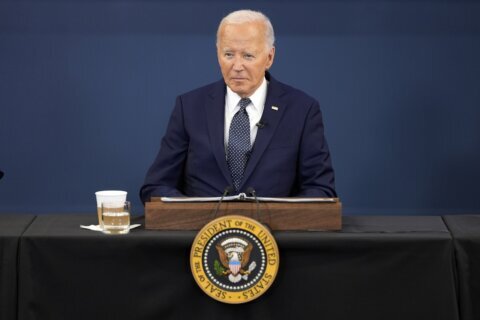
Pressure is building on Biden to step aside. But many Democrats feel powerless to replace him

Highlights from Supreme Court term: Rulings on Trump, regulation, abortion, guns and homelessness
Recommended.

'Super Bowl of fireworks': Go behind the scenes of DC's Fourth of July spectacle

Hitting the water for the Fourth of July? Md.'s Operation Dry Water aims to keep the fun in check

Fireworks Forecast: Hot, humid, stormy. But will that dampen the July Fourth fireworks?
Related categories:.
- International
- Today’s Paper
- T20 World Cup
- Express Shorts
- Mini Crossword
- Premium Stories
- Health & Wellness
UPSC Essays Simplified: How to write an introduction? – the fourth step
Introductions in essays are the first impression you will make on the examiner. but how to write an 'impressive' introduction in a good essay our expert has some tips. don't miss the essay exercise towards the end of the article..
UPSC Mains 2024 season has begun. One of the most popular questions in the aspirants’ minds for the mains preparation is: How to write essays for UPSC Civil Services Exams? We have an answer for you in the form of our new series.
In UPSC Essentials’ special series UPSC Essays Simplified , we take you through various steps of writing a good essay. While there is no set formula or fixed criteria prescribed, Manas Srivastava talks to Ravi Kapoor , our expert, in this new series who guides the aspirants with a simplified framework on how to write a good essay. Don’t miss ‘The Essay Exercise’ towards the end of the article.

Ravi Kapoor focuses on the following steps of pre-writing and writing stages which will help aspirants to write a ‘good essay’.
| (Previous article: ) | |
| (Previous article: ) | |
| (Previous article: ) | |
Today, we will focus on Step 4, the first stage of writing stage for UPSC Essays.
About our Expert: Ravi Kapoor IRS (R) , has now ditched his coveted rank of deputy commissioner and has offered free quality mentorship to UPSC aspirants, drawing upon his ten years of experience to create customised and productive curriculum. Through a free mentorship programme, he integrates tailored educational materials, psychological principles, visual learning techniques, and a strong emphasis on mental well-being into his teaching skills granting aspirants a chance to learn from his expertise.
Why is a ‘good’ introduction very crucial for a ‘good’ UPSC Essay?
Ravi Kapoor: Introductions are the first impression you will make on the examiner. First impressions are not only the last impression but inform how we form judgments about the source of the object .

This is true for your essays as well. The introduction is the initial portion of your answer or an essay consisting of the first few sentences which the examiner will read before judging your answers.
Introduction sets expectations for the rest of the essay . Often, these expectations are maintained over time. So, your introduction is the opportunity to convince the examiner that your essays are superior – an expectation which the examiner will carry throughout the time your answer sheets are being judged.
How to write a good introduction for UPSC Essays?
To answer this question, let’s rephrase it:
What not to do while writing introductions?
1. Do not mention the conclusions of your essay in the introduction itself .
It is a fatal mistake to declare your conclusion at the beginning of your essay-answer. It shows a lack of foresight and does not make the reader want to read further. Moreover, you may realize while writing that you do not completely agree with your initial thoughts about the topic. It will be impossible to change the entire essay at a later stage since this is a timed paper-and-pen test.
2. Do not take a final stand about the topic at the beginning of the Essay
It follows from the point above that your opinion about the topic should be reserved for later in the Essay. Don’t simply agree with the Essay topic or disagree with it in the introduction. Take the reader through all the arguments and examples which lead to your conclusion. Declaring a one-sided opinion at the beginning of the essay will force you into a corner later.
What is an ‘impressive’ introduction for UPSC Essays?
A ‘good’ or an ‘impressive’ introduction must:
1. get to the heart of the issue in the Question. This means that you should avoid being indirect and Introduce the core issue of the question in clear language in the introduction itself. Tell the examiner that you have understood the core of the issue and will use the main body of the Essay to analyze the issue logically.
2. engage the reader without being ambiguous. This means that the introduction should arouse the interest of the examiner , but this does not mean creating suspense or mystery . Remember that the essay-answers should be logical, clear, and concise.
3. summaries the main approach of the Essay. Your main approach can be analytical or expressive. In the UPSC exam, your essays should always be analytical. The approach also means giving the examiner a sense of the structure of your answer.
4. tell the examiner what to expect if they read further. Your introduction should give glimpses into the main arguments . Tell the examiner that you have examined the pros and cons of the Essay topic and have arrived at a perfect understanding of the issues involved.
What may be the various types of introductions that can help in a good start of an UPSC essay?
1. With a hook: A hook is an unusual start which grabs the attention of the reader. For UPSC type essays, hooks can be an anecdote, quote, poem or anything creative which gets to the heart of the debate you are trying to address.
However, effective hooks are rare, and are NOT recommended for beginners and should only be used by experienced writers who can pull them off. Remember that the UPSC is a competitive exam and not a test of creative writing.
2. Without a hook: A simple but effective introduction that sets the tone for the rest of the essay. It defines the core concepts (see previous articles on deconstruction of core concepts) and creates a solid structure for the upcoming arguments ( see previous article on creating a good structure and flow )
How to form impactful and impressive introductions?
Having brainstormed 12-15 keywords about the core concepts in an essay ( see previous article on brainstorming and ideation of core concepts), we can now use the 4Q2 technique to produce an impactful introductions for your answer-essays.
Consider the essay topic:
Can capitalism bring inclusive growth
Following the 4Q2 method, I answered the 4 questions in one or two lines and made sure to use the keywords from the ‘Structure and Brainstorming’ articles.
Here is a snapshot of structured brainstorming using the 12 QC on the given essay topic. The images represent the images which came to my mind when I asked the 12 questions.
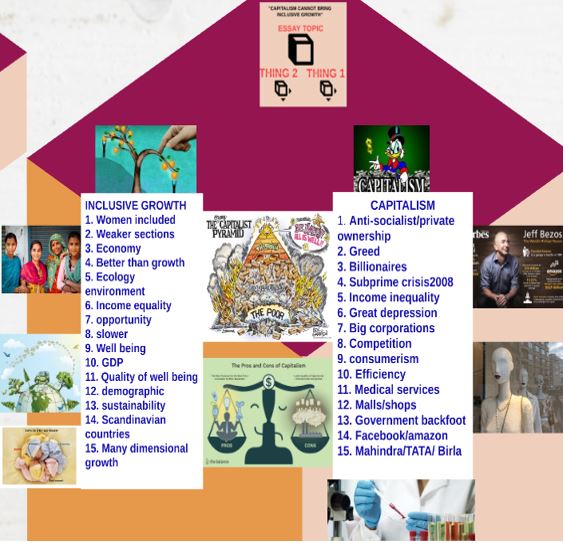
Keeping these words in front of me, I tried to answer the 4Q2 questions and produced the following sentences.
|
|
| ||
| 1. What do you understand by ‘ | Capitalism is an economic system which allows for private ownership and profit-making. | 1. What do you understand by and their importance | |
| 2. What do you understand by ‘ | Inclusive growth is multi-dimensional growth which includes different sections of society, all genders, and the environment. | 2. What do you understand by ‘ | |
| 3. What is the relationship between Capitalism and Inclusive Growth, as mentioned in the question? | At first, it seems like the relationship between Capitalism and Inclusive growth is an incompatible one and they do not usually co-exist. However, it is a rich interplay of many factors which make this relationship complex. | 3. What is the relationship between the 2 core concepts as mentioned in the essay topic? | |
| 4. Why is the relationship between Capitalism and Inclusive Growth important? | A harmonious relationship between Capitalism and Inclusive growth is of vital importance to the future of human society and the Environment. | 4.Why is the relationship between the core concepts important? |
Finally, after combining all the 4 answers in a sequence, we can obtain the following introduction:
Capitalism is an economic system which allows for private ownership and profit-making. Inclusive growth is multi-dimensional growth which includes different sections of society, all genders, and the environment. At first, it seems like the relationship between Capitalism and Inclusive growth is an incompatible one. However, it is a rich interplay of many factors which make this relationship complex. Nevertheless, a harmonious relationship between Capitalism and Inclusive growth is of vital importance to the future of human society and the Environment.
The Essay Exercise
Try the above method for the topic ‘ Forests are the best-case studies for economic excellence’. (Approximately 150 words)
How is the 4Q2 method useful in introductions?
1. I simply reused the keywords from the brainstorming sessions and did not need to produce any new ideas.
2. The introduction is packed with a lot of meaning . It directly defines the two main terms in the Essay topic and goes to the core of the issue which is- Can Capitalism and inclusive growth co-exist?
3. The introduction mentions the relationship and speaks of the importance of the wider context .
4. The introduction consists of about 80 words which is a good proportion to allocate for introduction for a 1000-word Essay.
5. I did not need to use a fancy hook or quote in the introduction.
6. This means that you don’t really need a lot of specialized knowledge to write a good essay.
| The advantage of this method is that you do not need to generate many new ideas for a question topic because most of the clues are already there in the 12-15 keywords which you have produced during structured brainstorming. Notably, the 4Q2 is of the Mains exam including Ethics, Essay, and General Studies. Regardless of where it is applied, the 4Q2 method will yield effective and powerful introductions to all your answer-essays. |
Subscribe to our UPSC newsletter and stay updated with the news cues from the past week.
The UPSC articles of Indian Express is now on Telegram. Join our Telegram channel- Indian Express UPSC Hub and stay updated with the latest Updates. For your answers, queries and suggestions write at manas.srivastava@ indianexpress.com .

Why TISS dismissed over 100 employees, why decision was reversed Subscriber Only

Sri Lankan Navy officer’s death & 10 Indians who now Subscriber Only
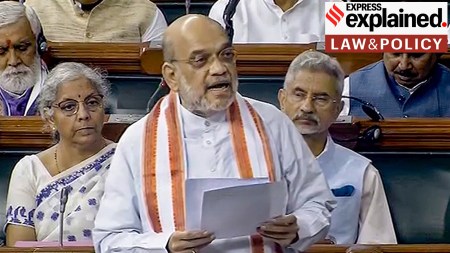
Explained: New crimes under the Bharatiya Nyay Sanhita Subscriber Only

UPSC Key | Chital, Project Nexus, Deep Brain Stimulation Device Subscriber Only

Chirag Paswan: ‘No power can take away reservations from India' Subscriber Only

India’s T20 World Cup win: Why Hardik Pandya is India’s

U'khand forest fires: Why villagers don’t help the state in Subscriber Only

In Bhopal, a race against time as new criminal laws Subscriber Only

How an interfaith relationship resulted in demolition of 6 houses Subscriber Only

The names behind the NEET paper ‘leak’ Subscriber Only

Manas Srivastava is currently working as Deputy Copy Editor with The Indian Express (digital) and majorly writes for UPSC-related projects leading a unique initiative known as UPSC Essentials. In the past, Manas has represented India at the G-20 Youth Summit in Mexico. He is a former member of the Youth Council, GOI. A two-time topper/gold medallist in History (both in graduation and post-graduation) from Delhi University, he has mentored and taught UPSC aspirants for more than four years. His diverse role in The Indian Express consists of writing, editing, anchoring/ hosting, interviewing experts, and curating and simplifying news for the benefit of students. He hosts the YouTube talk show called ‘Art and Culture with Devdutt Pattanaik’ and a LIVE series on Instagram and YouTube called ‘You Ask We Answer’.His talks on ‘How to read a newspaper’ focus on newspaper reading as an essential habit for students. His articles and videos aim at finding solutions to the general queries of students and hence he believes in being students' editor, preparing them not just for any exam but helping them to become informed citizens. This is where he makes his teaching profession meet journalism. He is also currently working on a monthly magazine for UPSC Aspirants. He is a recipient of the Dip Chand Memorial Award, the Lala Ram Mohan Prize and Prof. Papiya Ghosh Memorial Prize for academic excellence. He was also awarded the University’s Post-Graduate Scholarship for pursuing M.A. in History where he chose to specialise in Ancient India due to his keen interest in Archaeology. He has also successfully completed a Certificate course on Women’s Studies by the Women’s Studies Development Centre, DU. As a part of N.S.S in the past, Manas has worked with national and international organisations and has shown keen interest and active participation in Social Service. He has led and been a part of projects involving areas such as gender sensitisation, persons with disability, helping slum dwellers, environment, adopting our heritage programme. He has also presented a case study on ‘Psychological stress among students’ at ICSQCC- Sri Lanka. As a compere for seminars and other events he likes to keep his orating hobby alive. His interests also lie in International Relations, Governance, Social issues, Essays and poetry. ... Read More
- Express Premium
- government jobs
- Sarkari Naukri
- UPSC Civil Services
- UPSC Civil Services Exam
- UPSC Essentials
- UPSC Specials

A woman in West Bengal committed suicide after being beaten by villagers for an alleged affair. Her husband blames the village panchayat and a TMC leader for summoning and assaulting her. Four arrests have been made, but the TMC government is facing backlash for not protecting women. The incident has sparked a debate over kangaroo courts and violence against women in the state.
UPSC Magazine

Read UPSC Magazine
- Delhi News Live Updates: IMD sounds heavy rains alert; thunderstorm expected today 13 mins ago
- Parliament Session Live Updates: PM Modi to speak in Rajya Sabha today as Parliament session draws to a close 41 mins ago
- Mumbai News Live Updates: Nawab Malik seen attending meeting of Ajit Pawar's NCP 56 mins ago
- NEET-NET Row 2024 Live Updates: Rahul Gandhi requests for debate on NEET in Parliament today 1 hour ago

Best of Express

Buzzing Now

Jul 03: Latest News
- 01 Blinken, top Zelenskyy aide discuss bringing Ukraine closer to NATO
- 02 Danve’s loyalty to Sena UBT helped him get post of legislative council LoP
- 03 Taiwan demands release of a fishing vessel detained by China’s coast guard
- 04 Italian landowner is arrested after an Indian worker bled to death in accident with farm equipment
- 05 Stilt plus 4: ‘Illogical’: people, institutions urge Haryana CM Saini to review decision
- Elections 2024
- Political Pulse
- Entertainment
- Movie Review
- Newsletters
- Web Stories

Revealed: Harvard Business School’s New MBA Essays For Applicants
- Share on Facebook
- Share on Twitter
- Share on LinkedIn
- Share on WhatsApp
- Share on Reddit

Harvard Business School’s Baker Library.
With just 10 weeks before its first application deadline on Sept. 4th, Harvard Business School today (June 25) revealed a newly revised application for MBA candidates, including a new set of three short essays along with a refresh on how it will evaluate applicants for future classes.
The new prompts?
Business-Minded Essay : Please reflect on how your experiences have influenced your career choices and aspirations and the impact you will have on the businesses, organizations, and communities you plan to serve. (up to 300 words)
Leadership-Focused Essay : What experiences have shaped who you are, how you invest in others, and what kind of leader you want to become? (up to 250 words)
Growth-Oriented Essay : Curiosity can be seen in many ways. Please share an example of how you have demonstrated curiosity and how that has influenced your growth. (up to 250 words)
NEW HARVARD BUSINESS SCHOOL ESSAYS PUT THROUGH BY NEW MBA ADMISSIONS CHIEF
Eagerly awaited by thousands of prospective students and admission consultants, you can bet that the admissions pages of the HBS website were continually refreshed all morning for a glimpse at the new essay. The Harvard Business School essay prompt for the Class of 2027 was posted at 10:30 a.m. with the opening of the 2024-2025 application online.
This year’s change was put through by Rupal Gadhia , who joined the school as managing director of admissions and financial aid last October. A 2004 Harvard MBA, Gadhia came to the school with no previous admissions experience, having been the global head of marketing for SharkNinja robots.
In explaining the change in a blog post , Gadhia noted that “we have refreshed the criteria on which we evaluate candidates. We are looking for applicants who are business-minded, leadership-focused, and growth-oriented…This is your opportunity to discuss meaningful or formative experiences that are important to you that you haven’t had a chance to fully explore elsewhere in your application…Be authentic, be yourself.”
WHAT HARVARD BUSINESS SCHOOL IS REALLY LOOKING FOR IN THE NEW ESSAYS
The school added some context to its new criteria for admission, more clearly defining what it means by business-minded, leadership-focused, and growth-oriented.
Business-Minded
We are looking for individuals who are passionate about using business as a force for good – who strive to improve and transform companies, industries, and the world. We are seeking those who are eager to solve today’s biggest problems and shape the future through creative and integrated thinking. Being business-minded is about the interest to help organizations succeed, whether in the private, public, or non-profit sector. This business inclination can be found in individuals with a variety of professional and educational experiences, not just those who come from traditional business backgrounds.
In Your Application: We will look for evidence of your interpersonal skills, quantitative abilities, and the ways in which you plan to create impact through business in the future.
Leadership-Focused
We are looking for individuals who aspire to lead others toward making a difference in the world, and those who recognize that to build and sustain successful organizations, they must develop and nurture diverse teams. Leadership takes many forms in many contexts – you do not have to have a formal leadership role to make a difference. We deliberately create a class that includes different kinds of leaders, from the front-line manager to the startup founder to the behind-the-scenes thought leader.
In Your Application: Your leadership impact may be most evident in extracurriculars, community initiatives, or your professional work.
Growth-Oriented
We are looking for individuals who desire to broaden their perspectives through creative problem solving, active listening, and lively discussion. At HBS you will be surrounded by future leaders from around the world who will make you think more expansively about what impact you might have. Our case and field-based learning methods depend on the active participation of curious students who are excited to listen and learn from faculty and classmates, as well as contribute their own ideas and perspectives.
In Your Application: We will look for the ways in which you have grown, developed, and how you engage with the world around you.
TIGHTER TIMEFRAME FOR ROUND ONE APPLICANTS
The new essay prompts come nearly two months after candidates to the school’s MBA program would more typically know what was expected of them. Some admission consultants say the delay over the prompt’s release, along with nearly a month’s slow down in releasing application deadlines, is “wildly insensitive” to applicants who will have less time than normal to prepare for the round one deadline of Sept. 4th.
That’s especially true because the most successful applicants to HBS have highly demanding jobs that consume the vast majority of their time. Many candidates go through multiple drafts of their essays to get them as close to perfection as humanly possible. MBA admission consultants are expecting a lot of up-to-the-deadline work this year to help prep candidates for Harvard and other top business schools.
The new application still preserves the post-interview reflection for applicants who are invited to a 30-minute admissions interview. Within 24 hours of the interview, candidates are required to submit a written reflection through the school’s online application system.
REACTION TO THE NEW CHANGE IS MIXED
Early reaction to the change suggests the likelihood of mixed reviews. “This is an uninspired and odd set of questions,” says Sandy Kreisberg, founder of HBSGuru.com and an MBA admissions consultant who closely reads the tea leaves of Harvard’s admissions process. “I don’t know how it’s different from what else do you want us to know about you, frankly,” he adds in a reference to last year’s single essay prompt.
“HBS has certainly moved from the abstract to the concrete,” believes Jeremy Shinewald, founder and CEO of mbaMission, a leading MBA admissions consulting firm. “Some applicants previously felt like they didn’t know where to start and some weren’t sure if they had answered the question, even when they were done. Now, the questions are quite straightforward and all have a cause and effect relationship — one where the applicant discusses the past to reveal the present or future. Smart applicants will understand how to share their experiences and, more importantly, how to relay their values. Some will mistakenly try to whack HBS over the head with stories of their epic feats, but the key isn’t to brag or embellish – the key is to simply create a clear relationship, via narrative, between past experience and true motivations.”
Shinewald found it astonishing that Harvard could not have made the change earlier. “It is, of course, surprising that HBS left applicants on edge until the last minute, all to create very traditional essays,” he adds. “As applicants learn in MBA classrooms, change can be hard and take time. The bottom line here is that these essays are somewhat of an applicant’s dream – they allow the savvy applicant to play to their strengths and draw on their best anecdotes and experiences to create a complete story. Some applicants will lament the absence of a ‘Why HBS?’ prompt, but my guess is that the admissions committee recognized that they would get an almost homogenous collection of essays touting the case method and other well known features. HBS gets some kudos for keeping the focus on the applicant.”
Adds Petia Whitmore of My MBA Path: “I think they reflect one of the traits of this new generation of candidates which is that they don’t handle ambiguity well. So it seems like Harvard had to spell out what they’re looking for way more prescriptively than in the past.”
Some, however, find the new essays a return to the past. “To me, the prompts feel quite regressive, and a return to the more formulaic approach that pervaded MBA applications two decades ago,” believes Justin Marshall, a New York-based MBA admissions consultant. “Because the previous prompt was so open ended, it forced applicants to be introspective and self-aware. You couldn’t just ramble for 900 words; you had to identify themes in your life to show how your personal experiences shaped your values, your leadership style, and your goals. Comparatively, these new prompts are much more paint-by-numbers. Applicants will likely cover the same ground in terms of topic, but there’s very little room for nuance and self-expression. I think it will be harder for applicants with less conventional backgrounds and experiences to differentiate themselves. I’m sure HBS grew tired of reading so many painfully earnest ‘life story’ essays, but I suspect they’ll soon find themselves yearning for essays that have a heartbeat and personality. 250 words just doesn’t allow for that unless you’re a very crafty writer.”
Whatever the case, getting into Harvard’s MBA program is still a daunting exercise. Last year, 1,076 of the 8,264 candidates who applied for admission to Harvard Business School gained admission, an acceptance rate of 13.2%, making HBS the second most selective prestige MBA program in the country after Stanford Graduate School of Business which had an admit rate of 8.4%. Harvard saw a 15.4% drop in MBA applications from the 9,773 it received a year-earlier.
Joint degree applicants for the Harvard Medical School, Harvard School of Dental Medicine, Harvard Graduate School of Arts and Sciences, Harvard Law School, and Harvard Kennedy School must provide an additional essay: How do you expect the joint degree experience to benefit you on both a professional and a personal level? (up to 400 words)
BIGGEST CHANGE IN HARVARD BUSINESS SCHOOL ESSAY IN NEARLY A DECADE
Joint degree applicants for the Harvard Paulson School of Engineering and Applied Sciences must provide an additional essay: The MS/MBA Engineering Sciences program is focused on entrepreneurship, design, and innovation. Describe your past experiences in these areas and your reasons for pursuing a program with this focus. (recommended length: 500 words). Applicants will also be able to respond to an optional essay.
In any case, it’s the biggest change in Harvard Business School’s application in nearly a decade. The last time HBS made a major switch, moving to the essay prompt it just eliminated, was in 2016. That change to just one essay with no word limit and a post-interview reflection was made by then admissions chief Dee Leopold.
When Leopold applied to Harvard as an MBA candidate in 1978, she had to write eight essays. Over her years as managing director of admissions, she first cut the essays down to four and then one, making it optional, and finally the one last prompt with a post-interview reflection, saying that applying to HBS should not be a writing contest .

OUR BUSINESS CASUAL PODCAST: The New HARVARD BUSINESS SCHOOL MBA Application: Fortuna Admissions’ Caroline Diarte-Edwards and ApplicantLab’s Maria Wich-Vila join P&Q’s John A. Byrne to offer applicant advice on how to answer the new HBS essay prompts
DON’T MISS: 2024-2024 MBA APPLICATION DEADLINES or HARVARD BUSINESS SCHOOL WILL NOW UPDATE ITS MBA ESSAY
Questions about this article? Email us or leave a comment below.
- Stay Informed. Sign Up! Login Logout Search for:

Advice Column: Insider Tips For Your MBA Applications

What Harvard Business School Really Wants: How To Ace The HBS Essay

How To Ace The INSEAD Video Questions

Why Are MBA Application Goals Important?
- How To Use Poets&Quants MBA Admissions Consultant Directory
- How To Select An MBA Admissions Consultant
- MBA Admission Consulting Claims: How Credible?
- Suddenly Cozy: MBA Consultants and B-Schools
- The Cost: $6,850 Result: B-School
Our Partner Sites: Poets&Quants for Execs | Poets&Quants for Undergrads | Tipping the Scales | We See Genius
Follow Eater online:
- Follow Eater on Twitter
- Follow Eater on Facebook
- Follow Eater on Youtube
- Follow Eater on Instagram
Site search
- Los Angeles
- New Orleans
- Philadelphia
- Portland, OR
- San Francisco
- Twin Cities
- Washington DC
Filed under:
- Queer Table
An Acquired Taste
After going on hormone replacement therapies, my taste began to change — but that effect wasn’t purely biological
Share this story
- Share this on Facebook
- Share this on Twitter
- Share All sharing options
Share All sharing options for: An Acquired Taste
/cdn.vox-cdn.com/uploads/chorus_image/image/73424114/BDeresse_HRT_Food_FinalRevised.0.png)
On my last trip to the Burbank Costco, I felt like I finally perfected my optimum shopping route. First, the personal care section for Kirkland-brand minoxidil, then a pallet of Diet Coke; last, a quick weave through the snack aisles in search of a 30-pack of “snacking nuts,” individually portioned packages of salted peanuts, cashews, and almonds. I had started consuming nuts at an unprompted, voracious daily rate, getting through a 30-pack in two weeks or less. I wasn’t sure what brought it on, after a lifetime of feeling pretty much nothing about nuts one way or the other. But I took a picture of the three pounds of snacking nuts in my cart and texted it to a friend anyway, with the message: “epic white guy snack . ”
I’ve been taking testosterone for two and a half years. Testosterone has broadened my jaw and receded my hairline, like my dad’s and my brother’s. My body is long-torsoed and my legs have newly muscular calves, a build that the men in my family call having “Lamberty legs.” Before I started hormone replacement therapy — before I was “a guy” — I never really cared about nuts (yes, you can laugh). Now well into my medical transition, I’ve found that my tastes have changed. Nuts are now my favorite snack, my go-to food. I’m at Target and Trader Joe’s every week looking for my next nut, where, in the aisles next to suburban dads who look more like me than not, I feel a kind of belonging.
Beyond the joke I won’t be able to escape here, nuts have become symbolic of a particular kind of masculinity for me. Both the seemingly biological change in my taste buds and my cultural associations with nuts have me evaluating my own gender expression, connecting the Midwestern men of my upbringing to the guy I’m creating. Standing in that Costco aisle, in relaxed-fit Lee jeans with a Gold Star membership and a value-pack of nuts in my cart, I recognized myself, for one of the first times I can remember, as a man.
When I began my medical transition, every doctor I met with took great pains to warn me about the changes my body would go through on testosterone. I had the top five side effects down pat after my second appointment: facial hair, lowering voice, bottom growth, fat redistribution, male-pattern baldness. I was excited about these changes. I wanted to grow an ugly little mustache. I wanted an expressive, deep voice. Those things came, in time, but what was never mentioned in my endocrinology appointments were the more nebulous experiences that occur when taking testosterone. My libido became almost unmanageable. I cried much less. And, it seems, my taste began to change.
When I noticed my taste buds reacting in new ways to nuts, something I’d eaten many times before to no major effect, it seemed like a straightforward hypothesis: My taste changed as a result of starting testosterone. As any good trans person would do, I took to Reddit, where I found hundreds of posts on the topic. “I used to really like spicy food, but I can’t stand it anymore.” “Does anyone else PERMANENTLY crave cold, smooth things like ice cream or pudding??” It seemed to be a common trans experience, yet with no through line between gender or taste or hormone introduced.
During a typical, cisgender puberty, hormonal changes affect one’s sense of taste to an extent. Infants are born with around 30,000 taste buds that dull and diminish over time, perhaps explaining why bitter foods become more palatable in the teen years. A sex-based explanation of taste is more complicated, and often contradictory. A recent study stated that women are more frequently identified as “supertasters,” or people who are genetically more sensitive to bitter tastes, but men report higher sensitivity to sweet and sour foods across the board. The study also stated that “taste preference, detection ability, and response to tastants have gender differences. However, the exact nature of these sex differences remains undetermined.”
There certainly aren’t any comprehensive studies on transgender taste buds over time. There’s still little known about the longer-term effects of transgender hormone replacement therapies (HRT), besides, for example, the hit list of masculinizing traits I saw during my first year on T. An article in a 2016 edition of Translational Andrology and Urology sums it up: Studies on the long-term health of transgender people taking HRT “have small patient numbers, short or medium-term follow-up, and very few of the patients studied are over the age of 65,” leaving your average trans Googler with anecdote-driven web forums. Social ostracism, institutional mistreatment, a lack of vocabulary around and access to gender-affirming care and an ultimately low life expectancy — there are clear cultural reasons why trans people have a minimal presence in contemporary medical literature. And few long-term studies on the effects of trans HRT doesn’t mean hormone therapy is dangerous or inadvisable (it clearly hasn’t stopped me); thousands of Americans, cis and trans alike, regularly take hormones to safe, well-documented effects.
At the same time, there’s a tendency for trans people to inventory our lives pre-transition in search of latent gender confusion, incidents that we can point to and say definitively yes, this is who I’ve been the whole time, testosterone or spironolactone side effects be damned. But much like one’s taste is impacted by factors like “ cognitive restraint, attitudes toward foods, nutritional knowledge, social influence, and culture-based exposure ,” so, too, is my gender expression. Was I born this way? Kind of yes, and kind of no. I love cashews now in a way I never did before regularly taking testosterone; I love their smooth unctuousness, the new luxuriousness of salt and oil on my palate. Maybe that’s a function of the medication. But beyond that, starting my medical transition has given me a new lived experience. Now that I move through the world differently — as a man — I relate to food differently. I relate to it as a man.
I can argue that nuts are associated with masculinity. Baseball games, sports bars, break rooms — I’ve mostly understood nuts as a foodstuff for the working man, fast and satisfying. Flavor and pleasure are usually second to fuel and efficiency when it comes to nutrient- and energy-dense nuts. Again, there’s limited evidence suggesting that after puberty, cisgender men’s palates lean salty , which could explain a broad masculine love for nuts. There are further studies claiming cisgender men’s sexual function may benefit from daily nut consumption — maybe there’s something there. These disparate facts and settings add up, in my mind, to a generally masculine positioning. When I listened to a recent episode of the podcast How Long Gone in which hosts Chris Black and Jason Stewart raved about the nut medley offered at a hotel in Sydney, I found myself earnestly relating. I felt like I had learned about a secret guy thing , something I was finally in on.
When I eat Sriracha almonds or honey-roasted peanuts, I mostly think about my dad, born in Wisconsin and raised in South Dakota. I think about growing up in Minnesota, and the strange omnipresence of nuts. Peanut shells paving the floors of Wisconsin dive bars. Cheeks full of sunflower seeds at Minnesota Twins games. My brother dipping into a huge bag of almonds after a workout. All of my uncles, no matter whose house, having a big-ass tin of Planters peanuts in the pantry.
I came of age around a masculine modality that was joyful, communal. Between four uncles and 14 cousins, family parties in Sioux Falls were rowdy and jocular. My uncles were always generous with their time, with their homes, with cases of Busch Light. Rough-hewn. Sturdy stock. They taught me how to play cribbage and shoot a bottle cap across a room with my fingers. The men in my family were the kind of people I wanted to be: aspirationally masculine, imbuing Combos and home-brewed beer and peanuts with significance. My dad would sometimes just have nuts and a couple cheese sticks as a late lunch, which never made sense to me; post-transition, I find myself doing the same.
It’s a chicken-and-egg question I think about near-daily: Where does the biology of my transness end, and where does the emotional, cultural experience brought about by my transition begin? Can I attribute any change in how I move through the world to weekly testosterone injections alone? Taking testosterone to change my physical appearance and biological responses was the first step in my transition: baseline physiological, HRT the variable, and my pre-transition self the control group. But my transness, my masculinity, didn’t begin with my first dose of testosterone. HRT merely caused physical changes that allowed me to engage with my masculinity in entirely new ways. Testosterone affected what I look and sound like, and it maybe affected my sense of taste, but fully realizing the guy I want to be is more alchemical than purely biological.
Making the connection between an innocuous cashew and my particular blue-collar, Midwestern masculine influences made me feel like a part of something I always desperately wanted to be a part of. It’s not really about the cashews themselves, a value-neutral food. It’s about the men surrounding them. It’s about the thrill I get when I enjoy what I’m eating, then realize the broader context of it all. I’ve wondered if my newfound relationship with nuts as I continue to take testosterone is at all similar to what cis men experience during puberty: an exhilarating boil of hormones creating the conditions for crafting the masculinity of one’s dreams.
Thirty-pack of snacking nuts in tow, I went to the Costco self-checkout. I showed my membership card to the clerk. It was the last piece of identification I hadn’t updated with my new name and photo. The clerk looked at my out-of-date card, then me, and said, “Is she here with you? The owner of the membership?”
I did a little “Oh, that’s me, I — you know, I’m —” I wondered what the clerk thought. I wondered if she’d had this kind of thing happen before, if she saw what was in my cart and what it might all say about me. Were these the Costco purchases of a man? She didn’t really seem to care, and I was grateful for it. She waved me through the line. I proceeded through the self check-out, I grabbed my nuts, and I left.
AC Lamberty is a writer and filmmaker from the Midwest, now based in Los Angeles. Beck Deresse is a Black, queer illustrator who loves Brussels sprouts.
More From Eater
Sign up for the sign up for eater's newsletter.
The freshest news from the food world every day
Thanks for signing up!
Check your inbox for a welcome email.
Oops. Something went wrong. Please enter a valid email and try again.

Food Purses Are the Accessory of Summer

Momofuku’s Bo Ssam Recipe Can Be Yours in Less Than Two Hours

How to Feed the Olympics

‘The Bear’ Wants to Confront Toxic Restaurant Culture, But It Can’t Decide Who’s to Blame

‘The Bear’ Star Abby Elliott Studied Up for Her Role as Restaurant Manager

A ‘Good’ Billionaire Bought Anchor Brewing. What Happens to Its Union?

IMAGES
VIDEO
COMMENTS
Structurally, there are two different parts of a college essay where an anecdote is often found. The first is at the very beginning, and, in this case, your anecdote is used as a "hook" to engage your reader. One of the best ways to begin a college essay is with a "cold hook.". A cold hook is an abrupt anecdote that pulls the reader ...
Because an anecdote is a mini-story, you structure it in the same way that you would structure a longer piece. You introduce the story, you say what happened, and you either draw a conclusion or ask a question so your reader can reach his or her own conclusion. The main point you're trying to get across is your "punchline" (whether it's ...
Here are the key takeaways for how to write essay introduction: 3. Hook the Reader: Start with an engaging hook to grab the reader's attention. This could be a compelling question, a surprising fact, a relevant quote, or an anecdote. Provide Background: Give a brief overview of the topic, setting the context and stage for the discussion.
The best anecdotes help readers experience the moment or incident by including bits of dialogue so they can get into the writer's head and feel their pain, joy or other thoughts and emotion. HOT TIP: To start an anecdote for your narrative essay, begin by letting the reader know WHERE you were (just enough so they get the idea), and then put ...
To write a strong anecdote, you need to: 1. Know what you are trying to show or illustrate (by example) with your anecdote. 2. Include some type of adversity, problem, conflict, obstacle (if you want a powerful little story). 3. Start at the peak of the action in the moment. 4. Make sure something happens. It might take no longer than a few ...
I was soon itching and twitching like a scrappy dog. Next time I stop to smell the flowers, I'll make sure I'll do it with my eyes wide open." The anecdote provides a lead-in to the overall message of your speech or essay. For example, the next sentence after the anecdote could be: "Have you ever delved head-first into a situation and run ...
David Sedaris's 5 Tips for Turning Anecdotes Into Essays. One of America's preeminent humor writers, David Sedaris is known for his incisive social critiques. He writes about his own life in essay collections and non-fiction books, from his childhood in upstate New York to his high school years in Raleigh, North Carolina. Here, he covers ...
College-level essay writing, in their understanding, requires a stuffy, exacting formality—a holding in of one's breath. By sublimating their individual perspectives and voices, these writers are, in fact, setting aside their most effective argumentative tools. ... The Art of the Anecdote. The decision to include an anecdote also allows ...
Purpose of an anecdote. Anecdotes can be used for a number of purposes. Anecdotes, when used in both nonfiction and fiction as a literary device, have a greater significance.. For instance, some anecdotes provide the readers with a better grasp of a character's background or motivations by describing them in a manner that doesn't match the central narrative.
An anecdote is a short account of a specific person or a real occurrence. They make conversations that are considered to be personal. They are placed for the purpose of making the readers entertained. An example of an anecdote would be: "When I was a kid, I used to have a dog who happens to be my best friend.
How to Write an Ancedotal Essay. Come up with a list of ideas for your anecdotal essay. Think back to an important event in your life or other personal experiences that have affected you. Pick one story to use as the basis for your anecdotal essay. Discuss your ideas with a friend, teacher or peer and find out which story appeals to him or her.
Writing anecdotes requires fiction techniques: Use action verbs and go light on adjectives and adverbs. Even a brief story needs a main character. That character (real or imagined) must have a clearly defined challenge. Use dialogue, setting, conflict, tension, drama, action — yes, even in a very brief anecdote.
A personal anecdote about fishing is likely not the right story to tell when writing an essay on the benefits of a school uniform. Disconnected or inappropriate anecdotes run the risk of confusing ...
Nothing powers a college application essay like an engaging anecdote in the introduction. Often, you can pull an anecdote ( a mini true story) out of what you've already written and instantly transform it into an engaging read. ... The trick to anecdotes is to gather some details. Start with the 5ws—Who, What, When, Where and Why: Myself ...
An anecdote is a brief story used to make a larger point. Anecdotes can add a storytelling touch to your explanatory and persuasive writing—connecting your ideas to real life and real people. Here are some ways you can use anecdotes in the main parts of formal writing. Beginning: To Introduce a Topic
Below are the steps to start an argumentative essay. 1. Create an Outline. Creating an outline is the very first step of beginning your essay, whether it is an argumentative or any other essay. It will help you in maintaining a clear focus and staying close to the main theme and topic of the essay. 2.
Step 1: Hook your reader. Step 2: Give background information. Step 3: Present your thesis statement. Step 4: Map your essay's structure. Step 5: Check and revise. More examples of essay introductions. Other interesting articles. Frequently asked questions about the essay introduction.
Even though an anecdote is a short story, you should structure it the same way you would, a long story. First, introduce it, say what happened, and then draw a conclusion that corresponds with the point you're trying to make. Alternatively, you can also a question and let your readers let their own conclusion.
Firstly, try and pick an intriguing anecdote - one that is both significant and relevant to the topic at hand. Make sure that the story you choose is impactful and paints a vivid picture of the situation. Take it one step at a time. Additionally, aim to keep your anecdote concise - try not to ramble on with unnecessary details as this can ...
Hook the reader: Start your introduction with a captivating hook, such as a quote, anecdote, or intriguing statement. This will immediately engage the reader and make them want to continue reading. This will immediately engage the reader and make them want to continue reading.
1: HOW TO START AN ESSAY WITH "THE ATTENTION-GRABBING ANECDOTE". Anecdotes are an effective way for the student to engage the reader's attention right from the start. When the anecdote is based on the writer's personal life, they are a great way to create intimacy between the writer and the reader from the outset.
Notice how I started by describing myself "Crouched in a the far corner…". Begin by saying where you were, or what you were doing, then go from there. This is often a great way to get started. You want the anecdote to be from your point of view, right at the center of the action. At first, your anecdote might run long.
Start writing essays early to allow time for research and editing. Grab the reader's attention immediately with a compelling story. Answer questions directly with sound grammar and style. With so ...
Add a Comment. RuroniHS Hobbyist • 7 yr. ago. It depends on the essay. If it's academic, you probably just want to start with stating your thesis. 4. Reply. aesche Published Author • 7 yr. ago. It is considered "traditional" to begin an essay with an anecdote. You're totally fine.
To ensure you have plenty of time to make your essay shine, start writing 3-4 weeks before the deadline. This way, you have time to write a draft, step away, edit it with fresh eyes, and even ask a friend to look over your draft. ... As you read the essay prompt, think about specific anecdotes from your life that you can use to answer the question.
Start Early. Scholarships will ... Introductions like this, which drop the reader into the action through an anecdote or personal story, tend to be effective and persuade the reader to keep ...
It follows from the point above that your opinion about the topic should be reserved for later in the Essay.Don't simply agree with the Essay topic or disagree with it in the introduction. Take the reader through all the arguments and examples which lead to your conclusion.Declaring a one-sided opinion at the beginning of the essay will force you into a corner later.
Eagerly awaited by thousands of prospective students and admission consultants, you can bet that the admissions pages of the HBS website were continually refreshed all morning for a glimpse at the new essay. The Harvard Business School essay prompt for the Class of 2027 was posted at 10:30 a.m. with the opening of the 2024-2025 application online.
On my last trip to the Burbank Costco, I felt like I finally perfected my optimum shopping route. First, the personal care section for Kirkland-brand minoxidil, then a pallet of Diet Coke; last, a ...